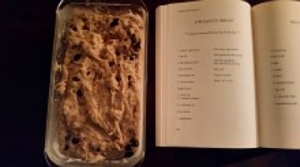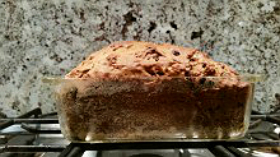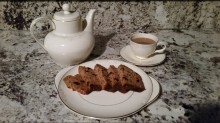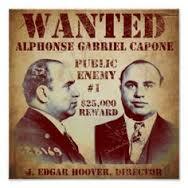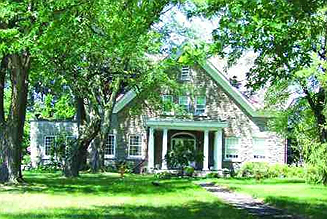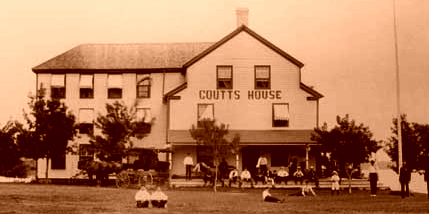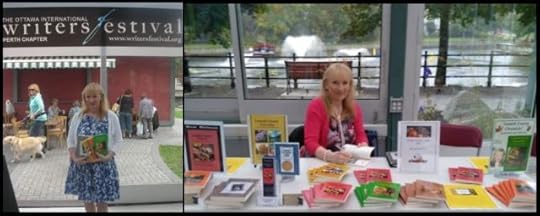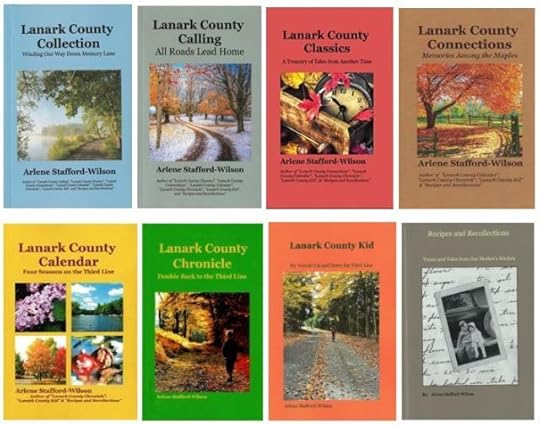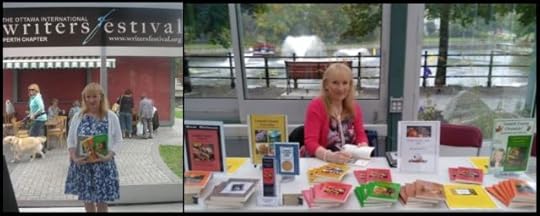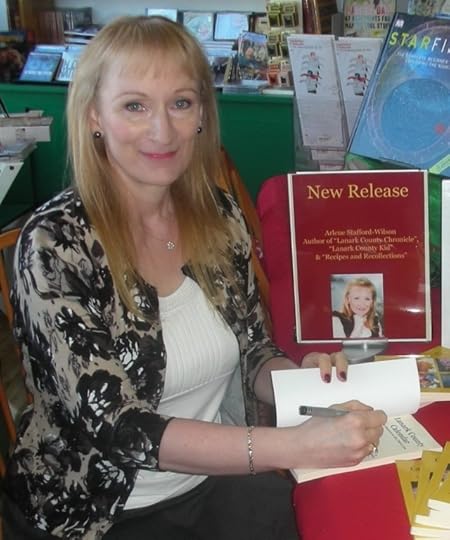Arlene Stafford-Wilson's Blog, page 18
August 16, 2023
Chaplin’s Dairy – Milk Route
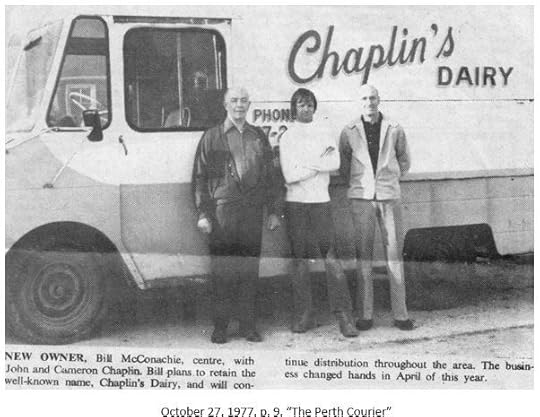
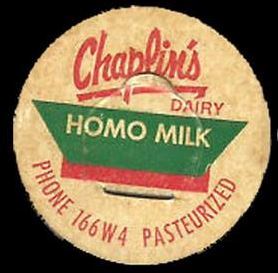
Bottle cap – used to seal the glass milk bottles at Chaplin’s Dairy
“Did the milk taste better
from a bottle?”
Whether it was homogenized, skim, or buttermilk, yes, it all tasted better from a glass bottle than it does from a carton, or a plastic bag. My all-time favourite product from Chaplin’s Dairy was their chocolate milk, which came in a pint-sized glass bottle, sealed with the same cardboard cap. On a hot lazy summer day there was no better sight than seeing Dad walking across the yard with his milk carrier, and a couple of pints of Chaplin’s rich, creamy chocolate milk.
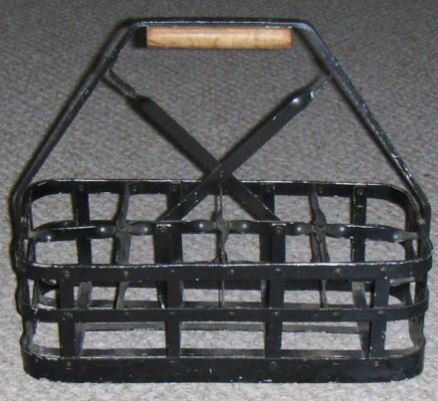
Milk carrier – room for 8 quart bottles

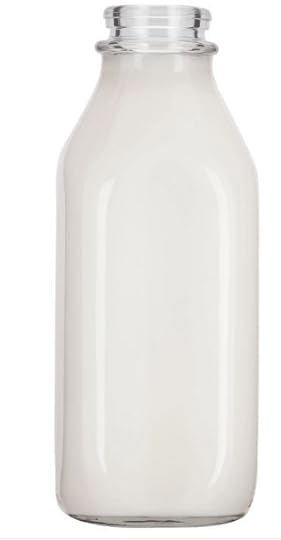
Along with the quarts of whole milk, 2% milk, skim milk, and the pints of chocolate milk, Chaplin’s also produced buttermilk, whipping cream, and through the late 1960s, sold Beep brand grape juice and orange drink.

Stafford House
It was an early start to the work day when Dad left our house in the morning, and drove his car to Glen Tay. Once at Chaplin’s Dairy he made several trips in and out of the building, loading up the truck, preparing for the drive to Perth.
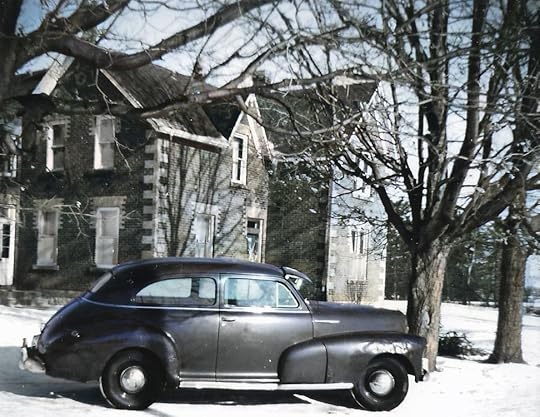
The Stafford house, 3rd Line of Bathurst, 1947, where Tim and Audry Stafford settled after the war. The property was purchased from Tim’s aunt and uncle, Clara (Richards) Carberry and Tom Carberry
One of Dad’s perks of delivering milk door to door in Perth every day was receiving all of the kind and thoughtful gifts from his customers. He was always late getting home on Christmas Eve because along with the cards and gifts he was given, everyone along his route wanted to stop and chat for a minute or two and wish him a Merry Christmas. He arrived home carrying stacks of envelopes with Christmas cards, and in each card was a one or two dollar bill. Some customers gave him boxes of assorted chocolates, chocolate-covered cherries, or peppermint patties. He was also given many packs of cigarettes as a gift, and if they weren’t his brand, MacDonald’s Menthol, and in later years, Kool, and Craven M, he traded them at Murray Dowdall’s Service Station in Glen Tay.
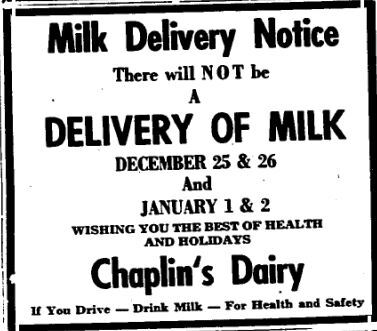
December 19, 1968, p. 4, “The Perth Courier”
Tools of the Trade
Two of the things that Dad was often seen with were his change pouch and his black notebook. The black pouch held small bills and coins, so that he could make correct change for the customers when they paid. The small black notebook had a leather cover, and had slips of paper marked with lines, columns, and the heading, ‘Chaplin’s Dairy’, and a black carbon paper underneath, then a plain paper copy under that. On the top copy, he wrote the customers name, address, order, and amount due, which copied the order through the carbon paper onto the plain sheet below – the dairy’s copy.
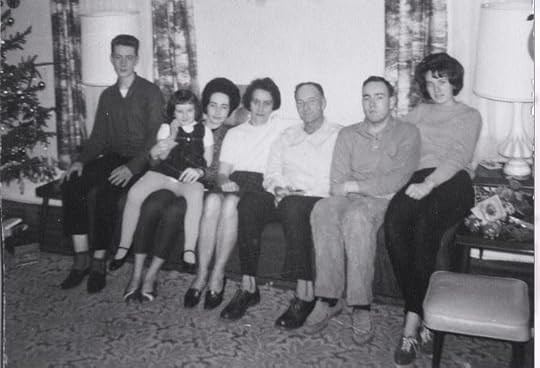
Stafford Christmas 1964, left to right: Roger, Arlene on Judy’s knee, Audry, Tobias ‘Tib’, Tim, and Jackie
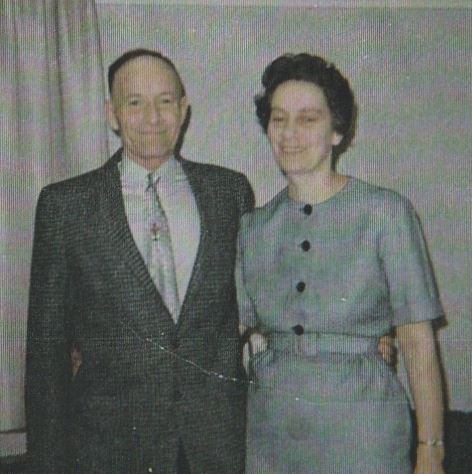
Tobias ‘Tib’ ‘Tim’ Stafford and Audry (Rutherford) Stafford, 25th wedding anniversary 1968
Chaplin’s Dairy
The dairy was founded by Delbert Chaplin in the early 1900s, and his brother Edgar Chaplin worked with him in the business. The Chaplin family owned a large 300 acre farm at R.R 4 Perth. At first he operated the business from their farm, but later in 1935 he constructed the Chaplin’s Dairy building at Glen Tay corners.
For over 25 years, from 1950 – 1976, our Dad, Tobias ‘Tib’ ‘Tim’ Stafford, delivered milk for Chaplin’s Dairy.
Where did he go on a typical day, who were his regular customers, and what was it like driving around with him in the big pink and white delivery truck?
My brothers, Tim and Roger, at different times over the years, worked as ‘Helpers’, on the milk route. What are their recollections of those days delivering milk for Chaplin’s Dairy?

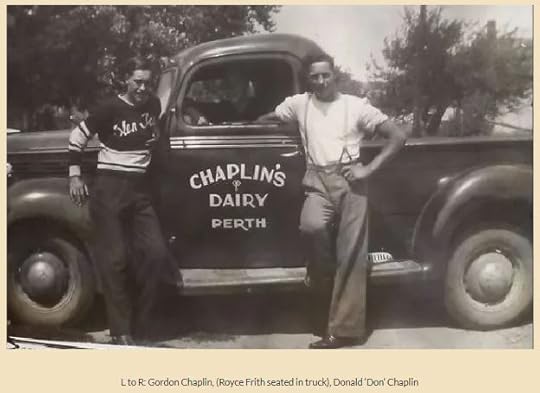
Tim’s recollections
of the Milk Route:
When he and Dad were loading up the truck early in the morning he recalls that Cameron Chaplin was there as well, loading up his truck at the same time.
There was a big walk-in cooler where they stored the milk, and there was another area where the buttermilk was stored by the big sink. It was Don Blair’s job to rinse out the buttermilk bottles and they often came back with some buttermilk hardened on the bottom of the bottle so it was all the more difficult to get those bottles clean.
After they loaded up the milk truck, their first stop was at Glen Tay delivering to the houses by the train station. After that, they went back on the 3rd Line, headed to Perth, and made a few residential deliveries along the way.
When they got to Perth they delivered to a couple of locations that took longer than others because the owners or staff at these businesses always invited them in for a chat. At the Perth Hotel they always invited Dad and Tim in for a coffee, they insisted, and it was non-negotiable. Another place they were always invited in was Burchell’s. Scott Burchell was often busy loading up his own delivery truck with windows and doors, and at that time he was also Mayor of Perth. Regardless of how full his day was, he always wanted to chat.
Another stop each morning was at Dad’s Aunt Clara (Richards) Carberry at 85 Sherbrooke Street. Every day she made an oven full of buttered toast and kept it warm for them until they arrived and served it with tea, and peanut butter for Tim. That was around 8:00 or 9:00 each morning, after they finished delivering up and down Gore Street and the side streets. After that, they headed up Gore Street toward Charlie Donaldson’s service station.
They always pulled over at McGlade’s Gas Station for lunch. It was at the corner of Gore Street and Highway 43, and they parked outside and ate the lunch our mother packed, which was two scrambled egg sandwiches on homemade bread, and four homemade chocolate cookies. She also sent a thermos of tea for Dad. Once they’d finished eating what Mother had sent with them Dad headed into McGlade’s and bought two chocolate bars – one for each of them for dessert.
After they finished eating, Dad liked to visit Benny K’s and Hoffman’s stores and poke around the vast assortment of merchandise and see what they had for sale.
In the afternoon they delivered up and down the side streets in Perth, up the Scotch Line, and back into town. The last house on the north side of Church Street was also a place where their customers wanted to chat, so that stop also took longer than most.
That house on Church Street was the last stop in town, then they headed out Highway 7 toward Glen Tay. They always delivered to Cleroux’s store and garage and they also spent time chatting with them, then the last place they stopped before the dairy was Murray Dowdall’s Service Station at the corner of Glen Tay across from the railroad tracks. They often saw Don Blair and Ted Cordick at Murray’s, stopping by for a chat. (Hillis Conroy owned the station before Murray) Each night at Murray’s, Dad bought a Toronto Star and a brick of butterscotch ripple ice cream to bring home for Mother and us kids.
Back at the dairy, they unloaded their empty carriers and empty bottles.
Tim also mentioned that one day he was with John Chaplin on his route (he was practising the route for when John was on vacation) and they stopped at Ryder’s on Highway 7.) Mr. Ryder told John that the buttermilk he’d purchased from him had turned sour, so in response, John took the cap off and proceeded to drink the entire bottle bottle of buttermilk to prove that it was fresh.
Tim also did John’s cottage run which was to Christie Lake, and was only done in the summer. When Tim did John’s route, his helper, Don Lindsay and he, had lunch at the Bright Spot, and their meal was paid by the Dairy. The Bright Spot was owned by the Turcott family and Muz McLean worked the cash.
In the spring, Chaplin’s Dairy also sold maple syrup from the milk trucks, which was produced on Andrew Korry’s maple bush. Korry’s farm was across the road from us. Andrew’s daughter, Orpha, was married to John Chaplin.
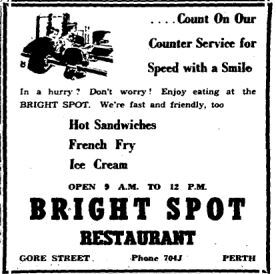
April 14, 1955, p. 6, “The Perth Courier”
(The Bright Spot was a diner located at 84 Gore Street E., in Perth, during the 1950s and 1960s. In 1969, Tony Noonan bought the restaurant, renaming it Noonan’s, then Tony’s son took over, and named it Peter’s Family Fare. Today is it’s known as Peter’s Restaurant and Bakery, owned by Chelsea and Mitch Fowler)
Roger’s memories
of the Milk Route:
“It has been a couple of years, but this is the way I remember the route.
After we left the dairy our first stop was at Nick and Doreen Webbers at Glen Tay, then up to Jack Dowdall’s on the crossroad, then we went down the south side of the train tracks to what they called the station house (it was torn down years ago) I can remember the boys that lived there were Jerry and Clause and that they were a German family, but I can’t remember their last name. We then backtracked to the crossroad and went East on Hwy 7.
We stopped at O’Gormans, Roger’s Auto Body, the house on the East side of Cleroux’s and then at the house by the pond. We then went into Perth with a stop on Drummond St and then down to Burchell’s. The remainder of the route was basically on the South side of the Tay River. We went out the Rideau Ferry Rd to McClenahan’s (she taught at the high school and they ran the planing mill) and out the Scotch Line as far as Watts.
We took Hwy 7 back to Cleroux’s, and then our final stop was Hillis Conroy’s / Murray Dowdall’s Service Station.
Our last delivery was at Korry’s across the road from our house. John’s wife Orpha was a Korry.
When we were young, Dad would return home with milk for Korry’s and one of us kids would take it across, and usually get a cookie from Mrs. Ethel Korry.
When I first started with Dad we worked out of a pickup truck and then a step van. Neither had refrigeration and freezing was always a concern in the winter. On Saturday we delivered two days worth of milk, so we had to go back to the dairy at noon, to pick up the second load. Dad worked 6 1/2 days one week and 6 the second week with either half a Sunday off or a full day.
On every second Sunday he went in to work in the dairy processing milk as milk arrived at the dairy 7 days a week.
Everything was in glass bottles, Whole milk, Skim, Chocolate, Buttermilk, Table Cream and Whipped Cream. Cartons came out about the time I stopped working with Dad (1967) People bought tickets, indicating what they wanted and they put them out in the empty bottles, so you knew what they wanted. Some people ran a bill, which Dad recorded in a book kept in the truck. He collected on those bills on Saturdays. We each wore a pouch which contained change and tickets. Saturday was a busy day because of the double delivery, the second trip to the dairy and doing collections. That is why all the routes had a helper on Saturdays. John’s son Gordon worked with him and Cameron’s son, Bob worked with his father.
The Summers were very hot and the winters were cold in the trucks as you were in and out all the time and with no air conditioning and poor heaters. It would still have been much quicker and more comfortable that using a horse and wagon.”
Note from Roger:
“Mom told me that after I was born, in February 1951, Dad picked her up in the milk truck to bring us home from the hospital. It had snowed and our side-road wasn’t plowed, so they had to walk in from the 3rd Line.
Dad worked at Wampole’s until he was 66 years old. I think after 10 years he was eligible for a small pension and some health benefits. That would mean that Dad left Chaplin’s Dairy when he was 56.”
(after being bed-ridden with pneumonia at the age of 55, Dad was advised by his family doctor to find a job working indoors, and so, his good friend, Nick Webber, referred him to a position with Wampole, where he worked until retirement)
Don Chaplin, ran the dairy farm that supplied a lot of the milk to the dairy. Don had two sons, Gary, and Grant, who worked on the farm with their father, and I believe they also worked at the dairy, doing the lake route in the summer. There were number of local farmers who supplied milk to the dairy.
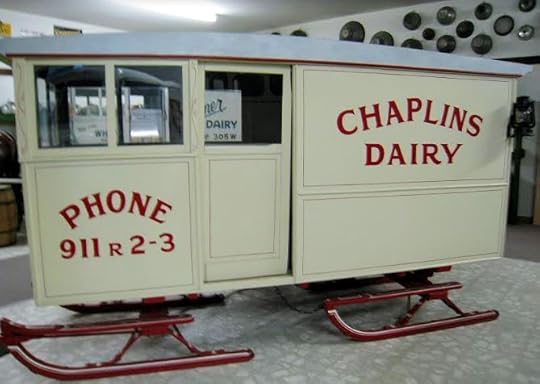
Chaplin’s Dairy sleigh, – Dairy Heritage Museum, Aylmer, Ontario
1969 – Perth Junior Farmers
Tour Chaplin’s Dairy
“The June meeting of the Perth Junior Farmers started with a tour of Chaplin’s Dairy, this being Dairy Month. John Miller introduced Mr. Chaplin to the group. Mr. Chaplin explained to the group the procedure taken to put out the homogenized, 2%, and the skim milk. The machine that fills the bottles and caps them, and also where the chocolate milk is filled up in cartons and sealed was shown to the group. Mr. Chaplin then showed the bottle washer. The machine washes, sterilizes, and rinses the bottles. We also visited the cold storage room where the bottled milk is kept. From the Dairy everyone went to the home of John Miller where we held the business part of the meeting.”
June 19, 1969, p. 14, “The Perth Courier”
1977 – Chaplin’s Dairy Sold
“Chaplin Brothers Bid Farewell to Family Business –
article from “The Perth Courier”, October 27, 1977, p.9
“The familiar pink and white trucks will still be there; – the friendly, courteous service will still be there, but the two men who kept the business going successfully for the last four decades will be gone.
John and Cameron Chaplin, former owners of Chaplin’s Dairy, sold their business this spring, ending a family ownership of close to 70 years.
“We’re going to miss it, alright”, said John, as he and his brother stood reminiscing in the cool atmosphere of the dairy’s grey cement interior. “Retired now? Well, more or less. I’d rather think of us as being on holidays at the moment.”, he laughed.
Although the Chaplins feel they were “at the business long enough”, it won’t be easy breaking that routine they have followed for so many years. John and Cameron made the dairy’s deliveries ever since they started working in the milk firm – John some 42 years ago and Cameron about 30 years ago. The last run was made by Cameron on September 17, 1977, just over a month ago.
John can remember when the price of the milk he sold was 5 cents a quart, back in 1935. The going price today for a quart is .65 cents.
And the two brothers recall when they used a horse and wagon for deliveries instead of the modern fleet of trucks the dairy uses now. It was a lot slower, but there weren’t many mechanical breakdowns.
In the earliest days of the dairy, started by Delbert Chaplin, John and Cameron’s father, milk was distributed with a pint or quart measure by the milkman, who simply ladled it out of milk cans into whatever container was left out on a front porch or stoop by the customer.
The birth of the dairy evolved from a large, 300-acre farm owned by the Chaplin family at R.R. # 4, Perth. Delbert Chaplin, a progressive man, set up a system so the farm could process its own milk produced by its Holstein cattle herd.
He erected a dairy building at Glen Tay in 1935, and the business flourished from there ever since. It became a complete family enterprise.
John, Cameron, and a third brother, Don, worked with their father to turn out as many as 3,000 quarts of milk a day, during the dairy’s peak production years. They distributed throughout the Perth and district area.
Although the sons took over the dairy operation in 1945, their father remained active in the firm for many years. Don took on the responsibility of managing the farm which was producing about 1,200 pounds of milk daily in the early 1960s.
Chaplin’s Dairy also processed the milk supplied by five neighboring farms in order to keep pace with customer demand.
Buttermilk and chocolate milk also left the dairy house for sale. Butter was produced too, but never enough to be sold. The Chaplins had a large enough clan that they consumed it all easily.
With the passing of years, the Chaplin family, like everything else, spread out and began to disperse. Life changed and in 1970, Don decided to sell the farm.
1974 – Processing Milk Ends
When John and Cameron finally gave up processing milk at the dairy in 1974 and turned strictly to distribution for Clark’s Dairies in Ottawa, Chaplin’s had been one of the very last small dairies still in the processing business.
“We had to quit. We had to go with the changing of the times”, said John. “There would have been too many changes to make in the dairy to keep up the operation.”
There was the change-over from glass bottles to paper cartons and plastic jugs. As a processor, the dairy had washed and recylced its own bottles, but glass became more expensive and more scarce.
“When we became a distributor, the bottles went. We got rid of the ones we had with no trouble by selling them to bigger dairies that still used them.”, recalled Cameron. “But some people still miss them. They think milk tastes better if it comes out of a glass bottle.”
The old bottle washer is still in the Chaplin’s Dairy building, but it’s rusty and old with disuse. Most of the equipment for processing the brothers sold, with some pieces, says John, going as far as Newfoundland.
As a processor, the dairy would have also had to comply with ever increasing government regulations. The business had never had any problems in the past, but things were not going to get any easier. The Chaplins wanted to leave the operation with the knowledge they had put out the best milk on the market and at the best price.
One of the biggest factors in their decision to change was the rise in costs in everything from maintenance to distribution.
“Little businesses are fighting a losing battle”, say both John and Cameron. “An operation has to be big nowadays, or it just won’t make it. Look at the farmers. If they are commercial, then they have to have a really large operation.”
Then there was also the problem of eventually converting to metric measurement. Equipment would be obsolete, the expense of purchasing new machines, astronomical.
It was almost a matter of quit or go under. The Chaplins decided to call it quits.
And they were happy with that decision. Since going over to Clark’s the dairy has maintained its reputation for reliable delivery to its 1,000 present customers. There are 12 runs made with a staff of four salesmen, and milk is brought in daily from Ottawa.
The dairy also offers a complete line of dairy products now, including juices, cottage cheese, and eggs.
The firms’ new owner, Bill McConachie, plans to extend the milk route to Smiths Falls since rising costs mean a bigger market has to be found.
Bill, who has worked for Clark’s for a number of years, used to bring the milk from Ottawa by transport, but now uses his own truck.
He lives in Perth and has become a familiar face to residents who will no longer see either John or Cameron making the routes. For the two brothers, the dairy will now hold only good memories.
“We want to thank everyone, all our customers, in Perth and the area, for their support all the years we were in business.”
John and Cameron said later, as they left the grey dairy building, “We hope they will do the same for Bill.”
1982–End of Home Delivery

(excerpt from an article by Patricia Rivera, “The Milkman Cometh No More”, “The Perth Courier, March 31, 1982, p.2)
The Milkman Cometh No More
“It used to be a common sight – and sound – of early mornings: bottles clinking and dogs barking, as milkmen delivered milk, butter, and eggs to homeowners.
And even if contemporary milkmen had ceased delivering eggs and butter, and the cartons didn’t exactly jingle, there was a link to old times.
Now, however, home deliveries are ending, not only in Perth, but everywhere.
March 27, 1982
Last Day of Milk Delivery
in Perth
“It’s the end of an era”, says Bill McConachie, owner of Chaplin’s Dairy, which ceased making the delivery rounds here on March 27th, 1982. “In Ottawa, the major dairies had stopped making house deliveries some time ago. The writing was on the wall. We could see a general, steady decline in home deliveries.”
When Mr. McConachie purchased the dairy five years ago, he estimates there may have been between 300-400 home customers. But this year, that number was down to about 150 residences.
“It’s changing lifestyles. Years ago, a mother was home all the time. Home delivery was convenient, and it was a service they could pay for. With the economic conditions today, mothers of young families have to work out of the home.”
So now they choose to drop by a store rather than have milk delivered to their doorstep – where it freezes in the winter and goes bad in the summer because no one’s on hand to take it in.
As well, chain stores are able to offer customers considerable savings on bagged milk packages.
“They (buyers) can find bargains where they’re saving a dollar on a bag. In a younger family where they’re drinking a (3-liter) bag a day, they can save $7 or $8 a week.
“That’s pretty significant.
Older people, on the other hand, rarely buy large quantities of milk at a time, and since “you never get a deal on a quart of milk at the store”, they are inclined to “pay four cents more at the door than the store.”
Besides, for older people, home deliveries were always a tradition.
“Their lifestyle hasn’t changed that drastically. They still expect the milkman at 8:00 a.m. They set their watches by it.”, he says, commenting that calls from his home customers reflect that “None are terribly surprised – they are disappointed, perhaps – but not surprised.”
Mr. McConachie also admits that his favourite customers have usually been elderly, and he cites the Christmas gifts of home-baked cookies as an instance of how they’ve ingratiated themselves with him.
He says that in his business, you meet a real cross-section of the population, though for the most part he is usually dealing with women.
He’s had his favourites, and he’s had his tiffs, but he’s “never had a totally bad experience.”
Chaplin’s will continue to deliver milk to area stores, but face-to-face customer service has become a thing of the past.
There was no choice but to cease and desist.”
Chaplin’s Dairy For Sale
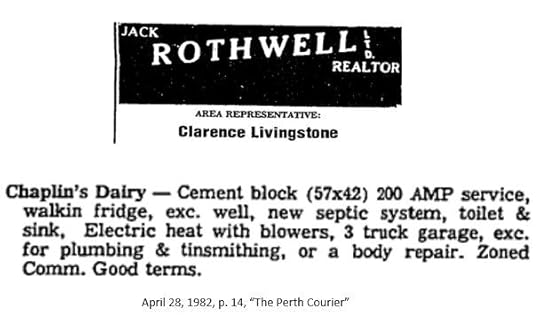
….And so it was, the end of an era, of home delivery service, of a friendly milkman arriving at your door with a metal carrier full of fresh milk and dairy products. For Dad, his days of delivering milk ended almost a decade earlier, after his bout of pneumonia, and his doctor’s orders to work indoors, not outside in the often bitterly cold winters of Eastern Ontario.
For those of us who knew John and Cameron, Don, Ronnie, and the helpers who worked on those long-ago milk routes, we will have our fond memories of that bustling business, that familiar grey cement building, with the ever-present steam rising up from the bottle cleaners, and some of the most delicious wholesome products ever produced, Chaplin’s Dairy, in Glen Tay.
To read more about Chaplin’s Dairy:
“Chaplin’s Dairy in Glen Tay”, from the book, “Lanark County Kid”
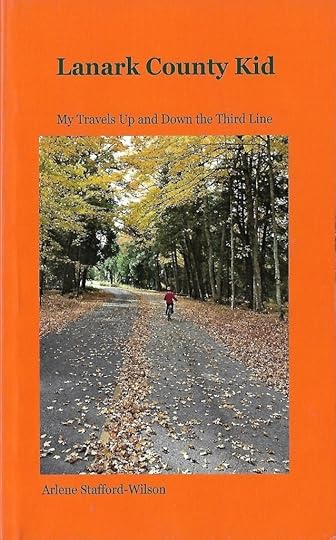
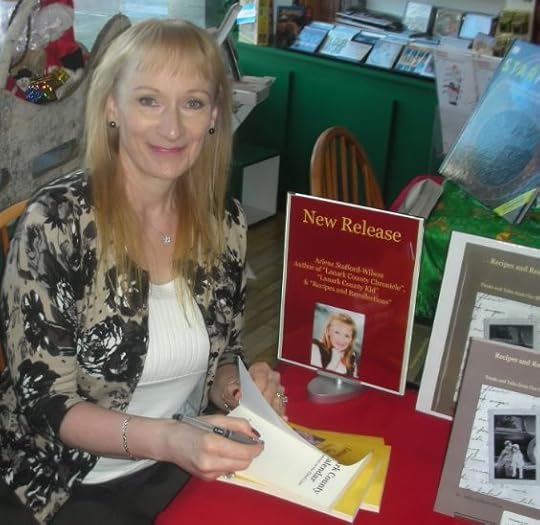
Arlene Stafford-Wilson
Honorary Life Member, Lanark County Genealogical Society
Member, Association of Professional Genealogists
Author of : “Lanark County Christmas”, “Lanark County Comfort”, “Lanark County Collection”, “Lanark County Calling”, “Lanark County Classics”, “Lanark County Connections”, “Lanark County Calendar”, “Lanark County Chronicle”, “Lanark County Kid”, & “Recipes & Recollections”
August 11, 2023
5 Lessons from Our Country Garden

Looking back, our humble garden on the Third Line of Bathurst Township in Lanark County, taught us some important life lessons.
1. PatienceWe learned patience, in the long, slow, process, of waiting months, for the vegetables to grow.
2. ResponsibilityWe learned the value of careful watchfulness, making sure that the weeds were pulled, and the ground was kept moist.
3. Enjoying the Fruits of our LabourWe also learned the rewards of hard work, as we carried the ripened vegetables into the house, anticipating the flavours of summer.
4. A Penny Saved, is a Penny EarnedAnother lesson was ‘thrift’, and the money that could be saved, in times when there wasn’t much money, in growing our food from seed.
5. A Quiet MindMost of all, we learned that working in the garden provided tranquility. It was an inner peace that comes from our hands working in the warm earth, and feeling the welcome heat of the sun soothing our faces and backs. Our country garden not only fed our bodies, but also nurtured our souls.
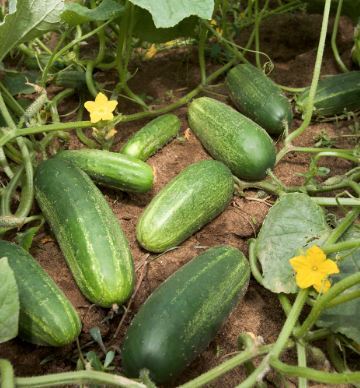
Mother made a special treat from our garden with cucumbers and onions, still warm from the earth. With a few simple ingredients, anyone can enjoy this gift from the ground, a Stafford family favourite. Prepared early on summer mornings, the mixture sat in a glass jar, on the old kitchen table, all day. As each of us passed by, our mouths watered, knowing those sweet, sharp, flavours would be the highlight of the evening meal…
INGREDIENTS2 cups water
1/3 cup vinegar (apple cider, white, and rice wine – your favourite)
2 Tbsp sugar (optional)
1/2 tsp salt (if desired)
2-3 sliced garden cucumbers
Fresh sliced onion or fresh green onion (5 – 10 whole green onions – trimmed), or (½ c – 1 c sliced onion)
Additional vegetables may be added (sliced sweet bell peppers, crisp fresh celery, whole cherry tomatoes)
Method:In a bowl, or large glass jar, add the water, vinegar, sugar, and salt.
Stir to dissolve the salt and sugar. Add the onions and cucumbers.
Let stand for at least four hours, until you are ready to eat.
(you can refrigerate if you like, but Mother let the mixture sit in a glass jar, on the kitchen table, from early morning, until supper time)
Enjoy!
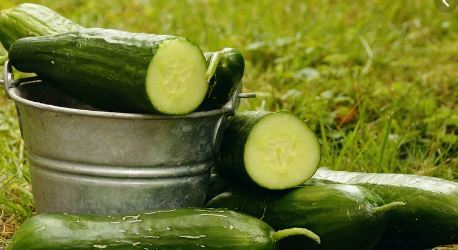
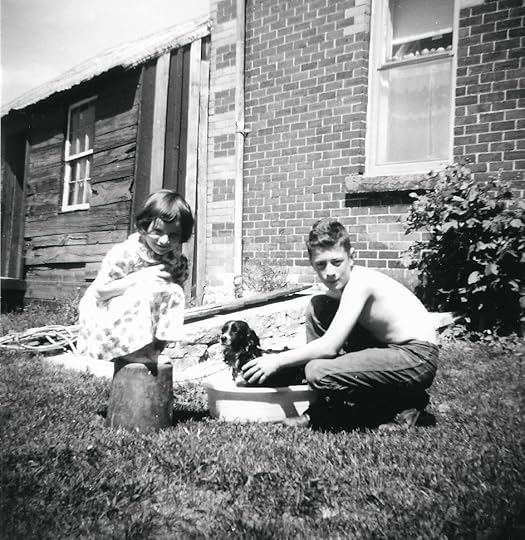
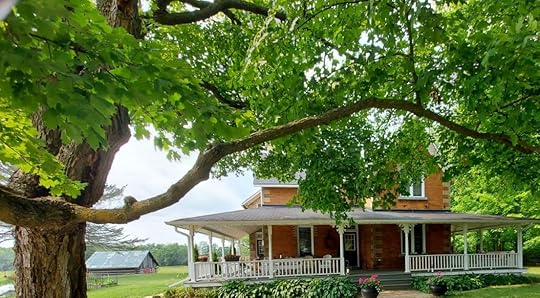
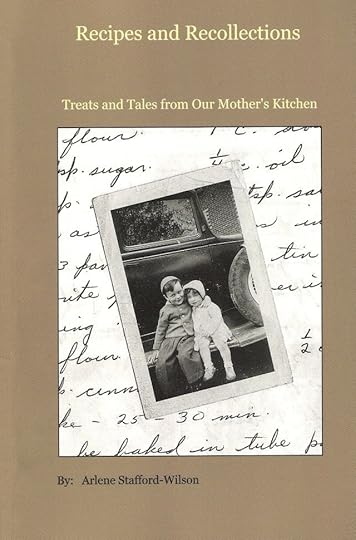
.
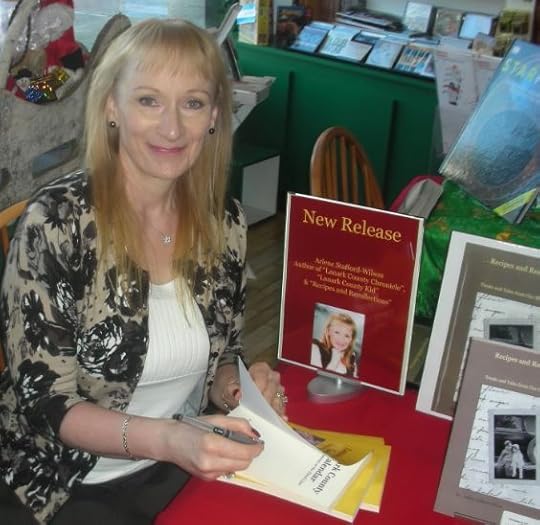
Arlene Stafford-Wilson
Honorary Life Member, Lanark County Genealogical Society
Member, Association of Professional Genealogists
Author of : “Lanark County Christmas”, “Lanark County Comfort”, “Lanark County Collection”, “Lanark County Calling”, “Lanark County Classics”, “Lanark County Connections”, “Lanark County Calendar”, “Lanark County Chronicle”, “Lanark County Kid”, & “Recipes & Recollections”
August 7, 2023
Lanark Museum – A Visit to the Past
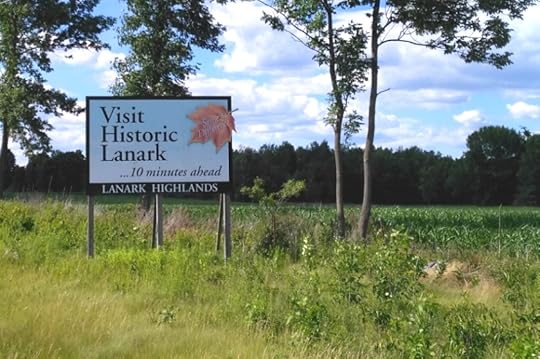
Just a short drive from the pretty town of Perth, along the Lanark Road, lush green farmers’ fields welcome us into the Township of Lanark Highlands. We follow the blue skies, and warm, summer winds, into the village of Lanark, and pull up near our destination – the Lanark and District Museum.

Greeted warmly by Anne Graham, we make our way up the well-worn steps, into a very special place, where the caretakers and guardians of our history, preserve our memories, our stories, and our heritage.
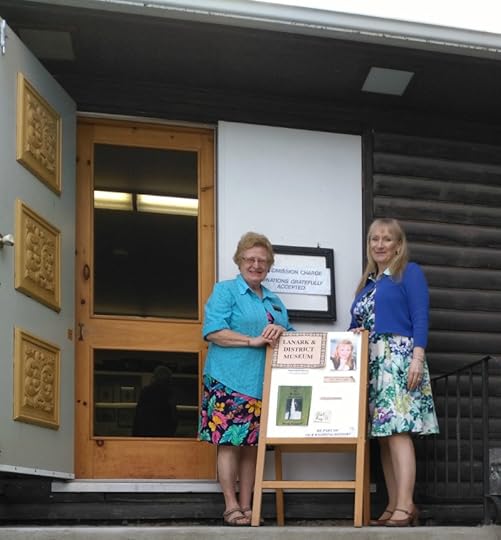
If you walk along George Street in Lanark, you will see a sign out front, greeting visitors, listing upcoming events, and welcoming all, with no charge for admission, and donations accepted. Anyone seeking knowledge, or in search of their history, is assured that they’ve come to the right place.
Not far from the front entrance, a plaque displays the names of those who went above and beyond, volunteering their time and expertise, throughout the decades, to keep the museum running smoothly.
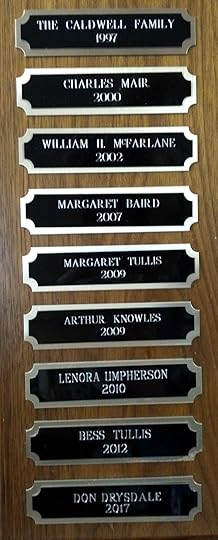
A photo on the wall reminds us of those who played key roles in the earliest days of the museum. Their foresight and dedication to preserving our local history leaves a lasting legacy, that will be enjoyed for many generations to come.
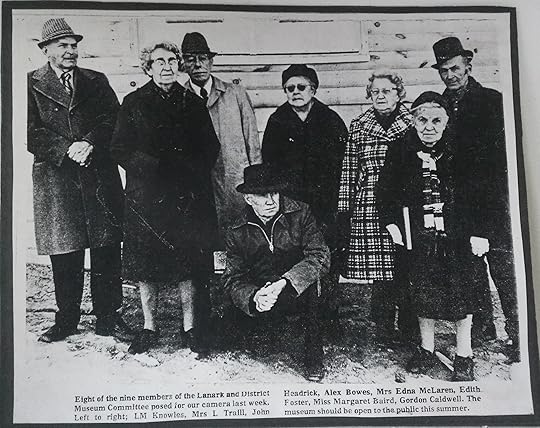
Many of us have ancestors from the area who served in the military, and the Lanark Museum has many displays highlighting our local heroes. Perhaps your ancestor is one of these soldiers who has been featured in the museum’s display cases.
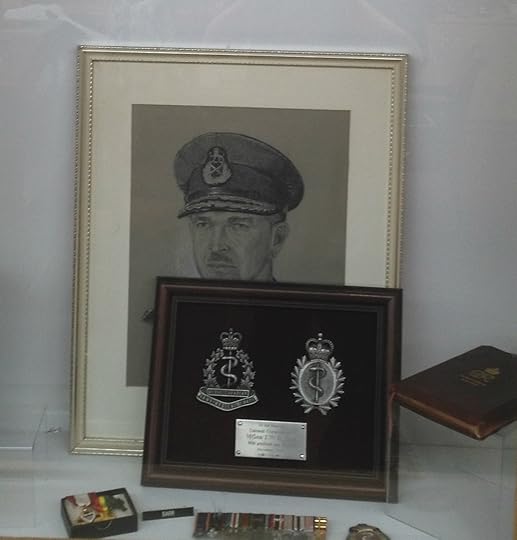
The museum also features a number of Rolls of Honour, listing the names of soldiers from the area who fought bravely for our country.
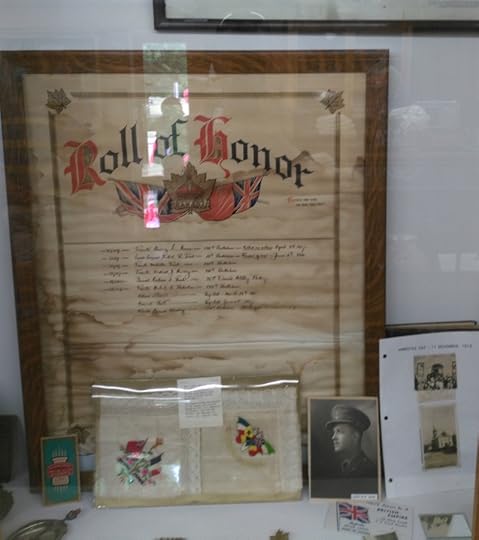
There are a tremendous number of local photographs. It’s great fun to see the old cars, some of the buildings no longer with us, and even recognize some of the smiling faces in these photos.
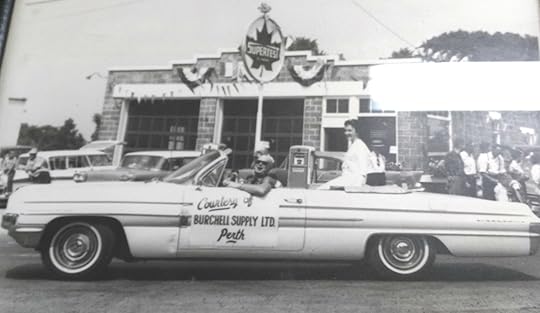
The museum is fortunate to have the help of two students for the summer. Meagan was kind enough to document our visit using her photography skills.
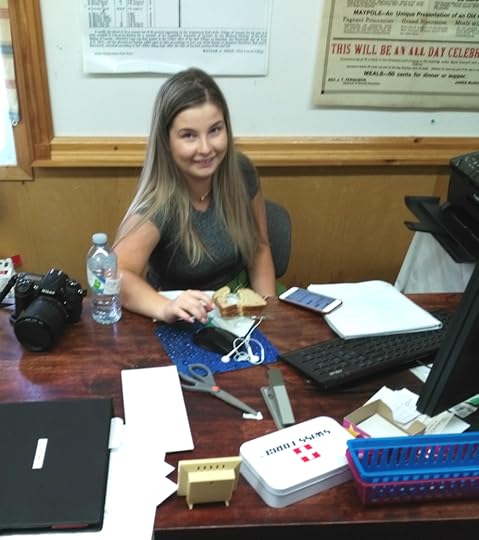
There is a wonderful display of original telegrams, some sent, and some received, by the Lavant Station, many years ago. These are real treasures, and give us some insight into the past and how different life was in those days! There are lots of familiar surnames on these telegrams, and some even provide a window into our family histories!
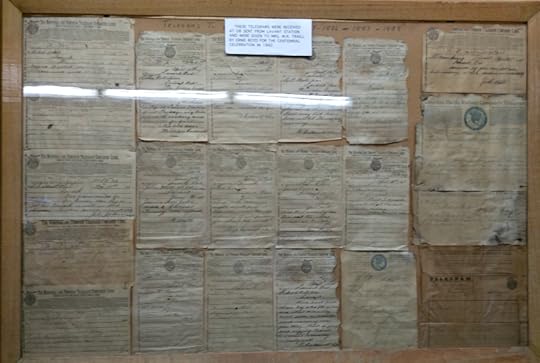
Along with the countless documents displayed there are also some lovely artifacts. The old wash bowl reminds us of the times before indoor plumbing was standard in our homes. We can imagine how different our ancestor’s lives might have been, and how carrying water from an outside well into the home was a daily event for these pioneers.
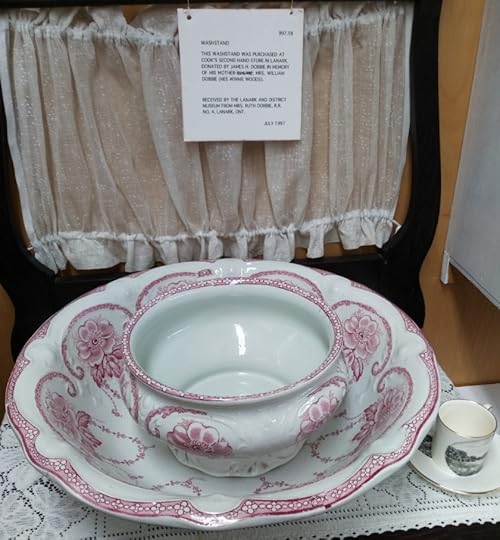
If your ancestors lived in McDonald’s Corners there is a wonderful remembrance displayed, honoring those who served their country, so well, and so faithfully.
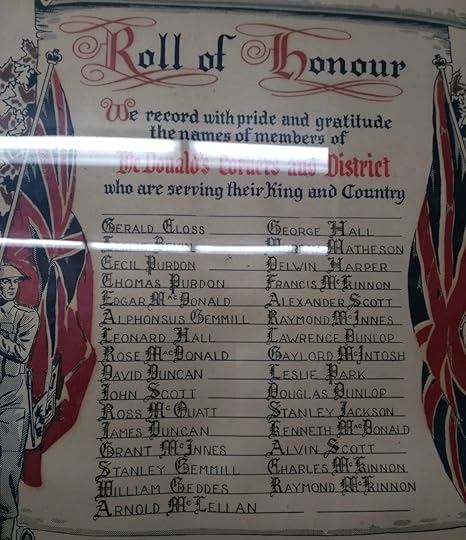
There are also a number of displays listing those soldiers who attended specific area schools and the names of those who served.
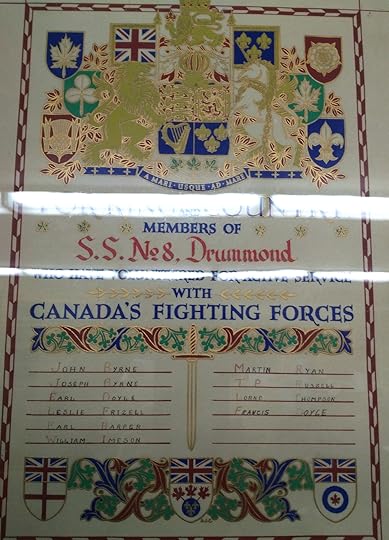
Another of the many area schools and their lists of those in service.
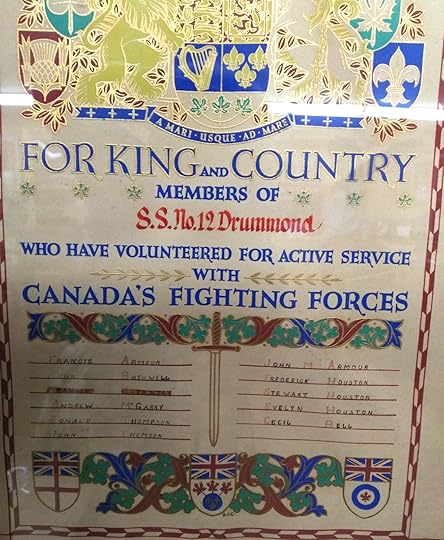
The Lanark Museum has many, many of these displays, and this is only a small sampling of what is available to view.
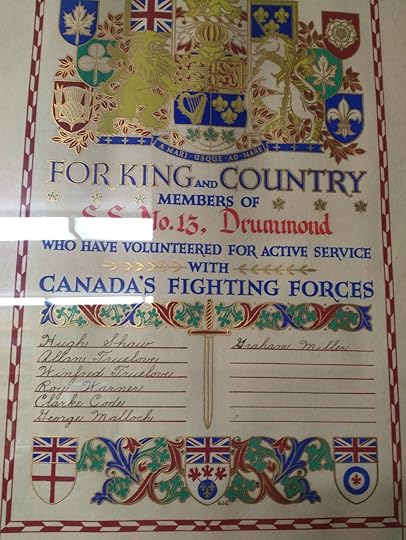
Being a history buff, it wasn’t easy to tear myself away from all of the exhibits in the museum, and get down to business, and read a couple of stories from my books. I chose two stories from “Lanark County Kid – My Travels Up and Down the Third Line”. I read one about a childhood visit to Lanark, and shopping for back-to-school clothing at the Kitten Mill.
My second story was “Balderson Cheese – Craving the Curd”. Our family often went on Sunday drives, and a visit to Balderson for a bag of soft squeaky curd, was something not to be missed! In the story, we go behind the counter, and watch the Master Cheesemaker, Omar Matte, and the others, while they stir the vats of heated milk, and then press the curds into big wooden circular presses. Considering that the factory is no longer there, it is a precious memory to have witnessed this process.
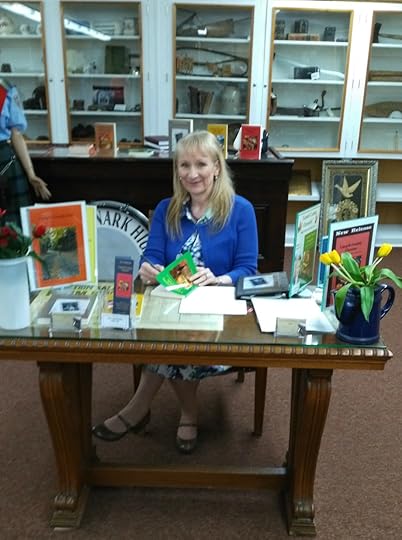
There are some really wonderful displays highlighting the Kitten Mill, and those who worked there over the years.
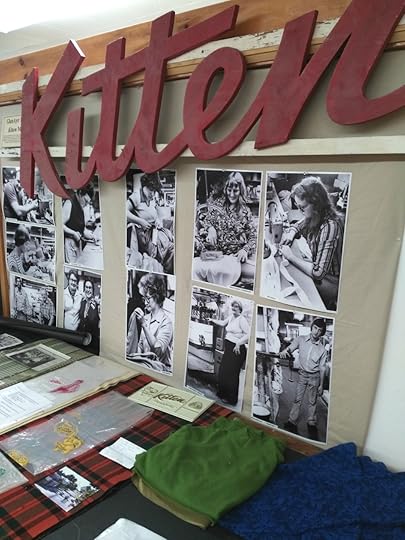
The Museum has done a wonderful job of preserving the artifacts and documents from the days of the Glenayr Kitten mills, and reminding us of the impact to employment and the economic influence to the village.
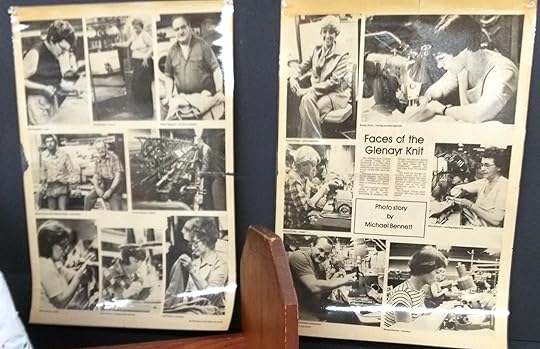
I think that many of us remember visiting the factory outlets, and all of the wonderful knitted clothing produced locally.
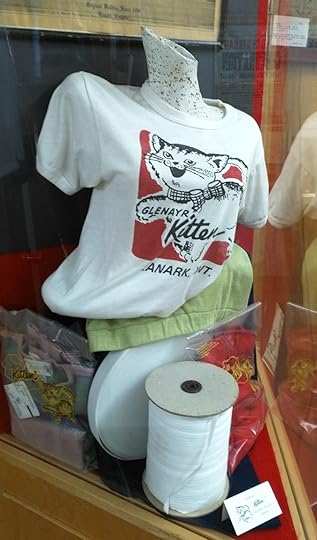
One of the special highlights for me was a visit with the Shamrock Quilt. While we can’t be sure of the date of its origin, I recall seeing it displayed at the museum many, many years ago, and was delighted to see it once again. This quilt is embroidered with the names of local families. If your family lived in the area it would be worth the trip to see this marvelous quilt, and discover your ancestor’s name embroidered in green.
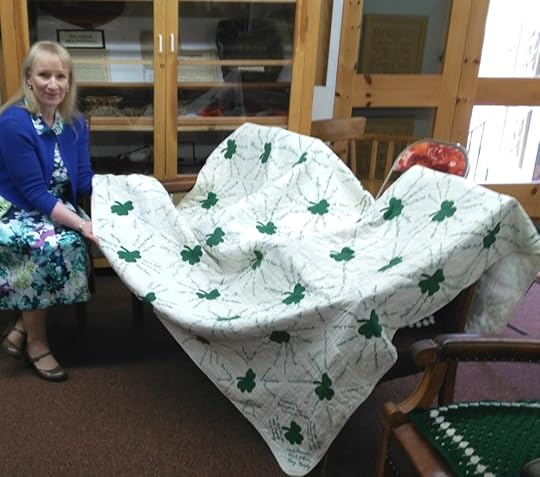
The Shamrock Quilt holds a special connection for Doris Quinn and myself. My Dad’s Aunt, Julia Stafford, married William Quinn, and both the Quinn and Stafford families are among the many, many, names on this precious artifact. It was a wonderful moment to be able to stand beside Doris, and see those names from the past, those who are no longer with us, but remain forever in our hearts.
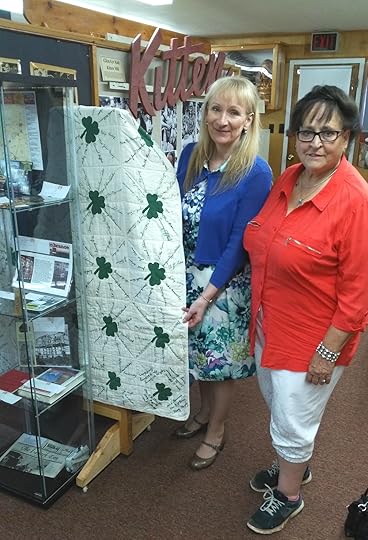 Photo below: Julia Stafford and Bill Quinn, on their wedding day, Sept. 14, 1909.
Photo below: Julia Stafford and Bill Quinn, on their wedding day, Sept. 14, 1909.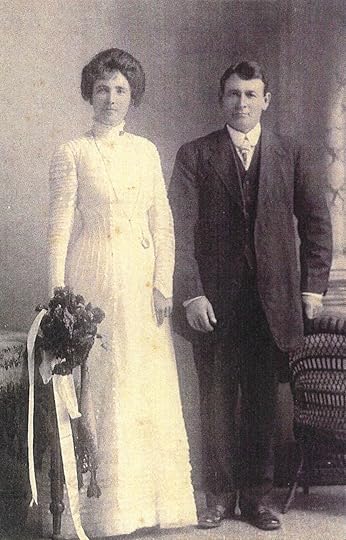
The following, are just a few squares, a small sample from the quilt, to show how the names have been stitched and displayed.
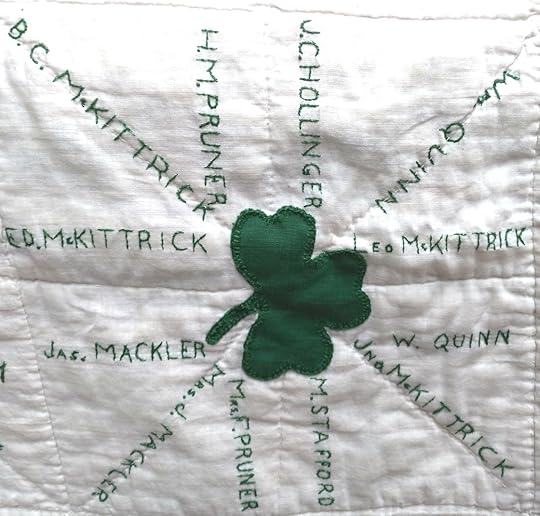
There are many other squares that were not photographed. Anyone with ancestors from this area may want to visit the quilt themselves for a more in depth look.
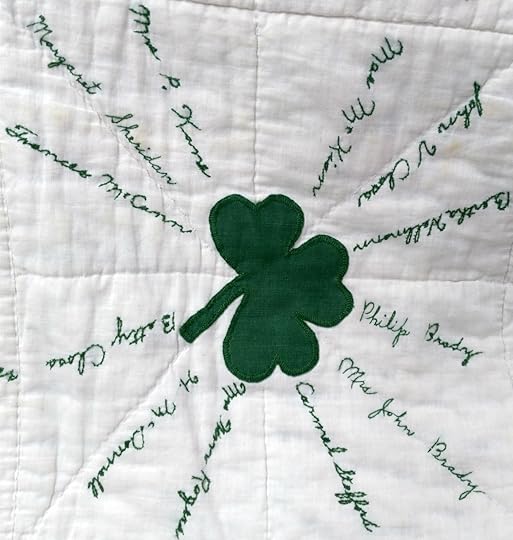
Another square of the quilt, but the quilt is enormous, and would be best viewed in person.
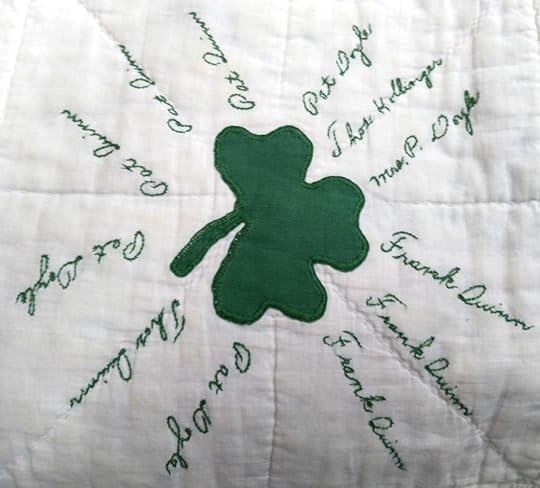
A final square from this historic piece. Hopefully the museum will photograph and digitize the entire quilt. That might be an interesting and very worthwhile project for the summer students!
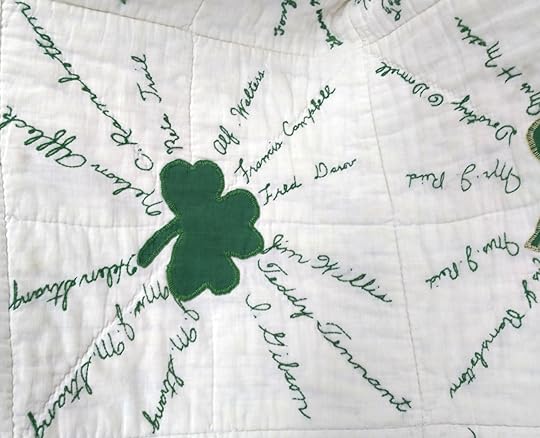
The late afternoon held a wonderful surprise – a visit from an old friend Susan Newberry Sarsfield. It was a real delight to visit with Susan, her Mom, and her daughter!
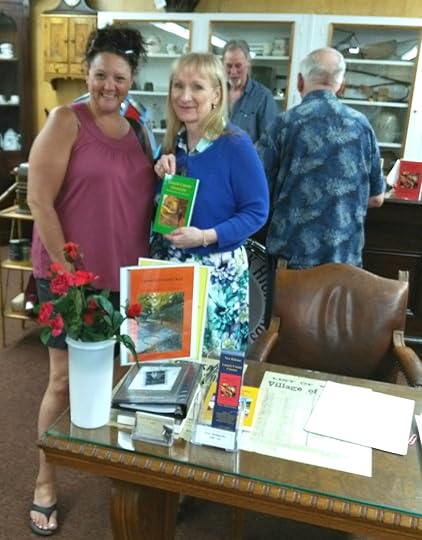
Like all good things, our visit to the Lanark Museum came to an end, and our host Anne Graham, kindly walked us out and into the sunny summer afternoon.
It was a day filled with history, and the importance of preserving our past. There are few tasks more essential than being the caretakers of our heritage. The Lanark Museum is the proud custodian of our region’s artifacts, memories, stories, and treasures.
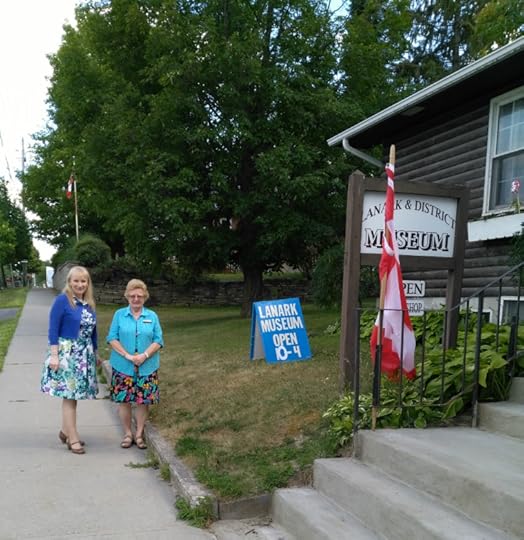
Many thanks to the kind folks at the Lanark and District Museum for hosting us, and sharing their collection of priceless treasures. Thanks also to the visitors who stopped by to share some stories and recollections. Anne, Norma, Gene, Doris – it was so nice to spend time with you – thanks for helping to make our day special.
As we said goodbye, and headed down the highway, we are struck by the pristine beauty of the Lanark Highlands, the clear waters, the fresh air, and the greenery as far as the eye can see, on this beautiful summer day.
Until we meet again…..
 Stories for the Lanark Museum readings from:“Lanark County Kid: My Travels Up and Down the Third Line”‘Lanark Sweaters – Soft as a Kitten’ and ‘Balderson Cheese – Craving the Curd’
Stories for the Lanark Museum readings from:“Lanark County Kid: My Travels Up and Down the Third Line”‘Lanark Sweaters – Soft as a Kitten’ and ‘Balderson Cheese – Craving the Curd’
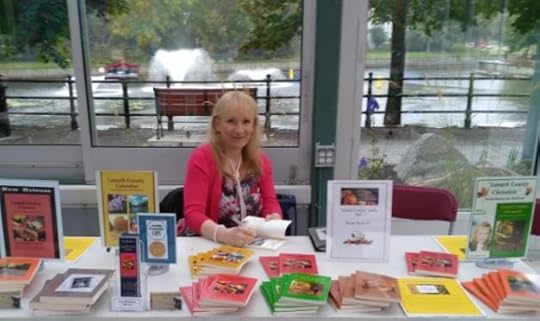
Arlene Stafford-Wilson
Honorary Life Member, Lanark County Genealogical Society
Member, Association of Professional Genealogists
Author of : “Lanark County Christmas”, “Lanark County Comfort”, “Lanark County Collection”, “Lanark County Calling”, “Lanark County Classics”, “Lanark County Connections”, “Lanark County Calendar”, “Lanark County Chronicle”, “Lanark County Kid”, & “Recipes & Recollections”
August 2, 2023
Carleton Place Old Days

First Known
as Morphy’s Falls
The first recorded residents of what is known today as the town of Carleton Place were Edmond Morphy, his wife, Barbara (Miller) Morphy, and their eight children. They arrived from Ireland in 1819, and were given a land grant of Lots 14 & 15 on the 12th Concession of Beckwith Township. The entire grant was 400 acres deeded to Edmond and his three eldest sons: John, William and James. The Morphy’s first house was a modest log home on Allan Street. As more settlers arrived, the town grew in size and a number of streets were named for members of the Morphy family: William, George, Morphy, James, Edmund, Thomas and Franklin Streets. By 1829, the town was renamed, Carleton Place, named for a town square in Glasgow, Scotland.
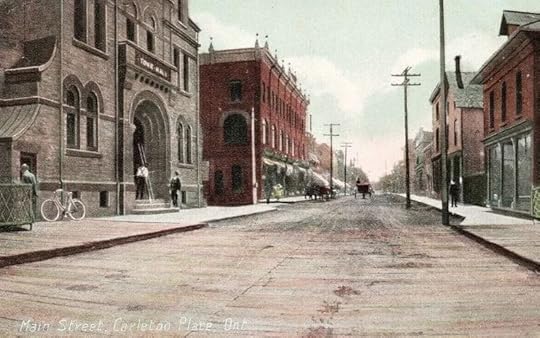
 July 14, 1928, p. 32, “The Ottawa Citizen”
July 14, 1928, p. 32, “The Ottawa Citizen”
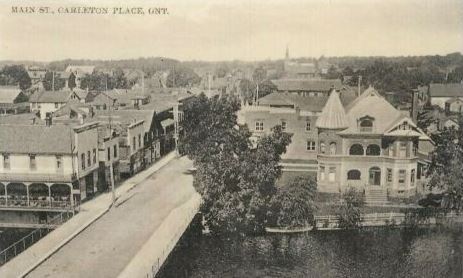
Town Hall
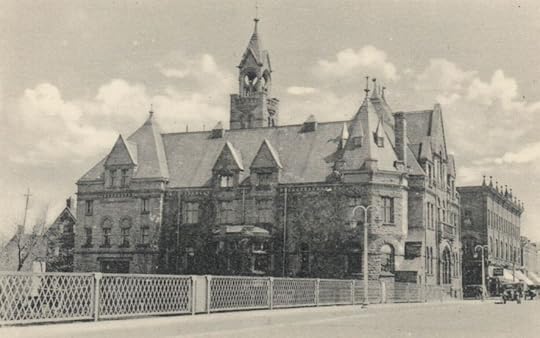
The town hall
was built in 1897
“Up to the year 1897, the town council met in a small building on the north side of the river, known as the old opera house.”
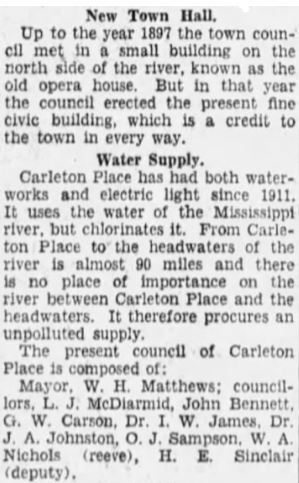
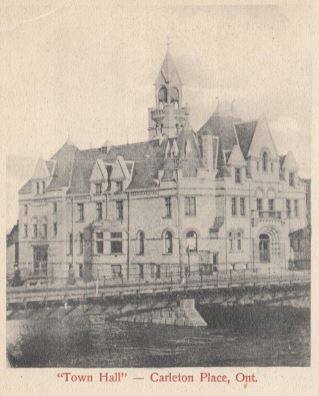
Findlay’s
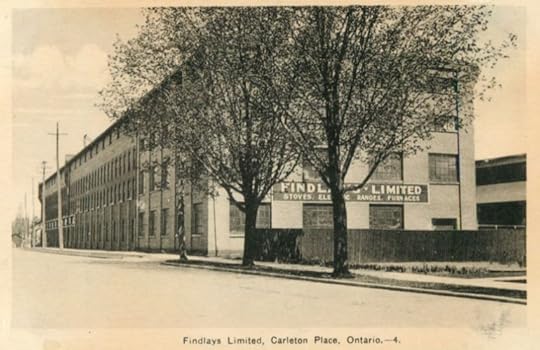
Main Street
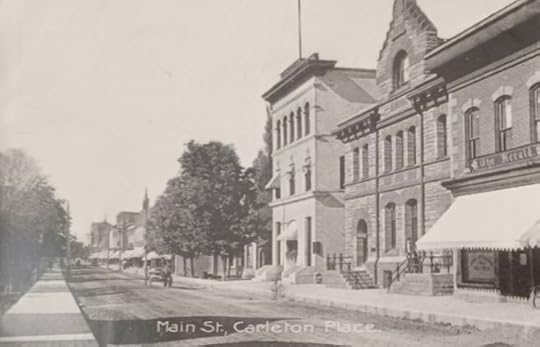
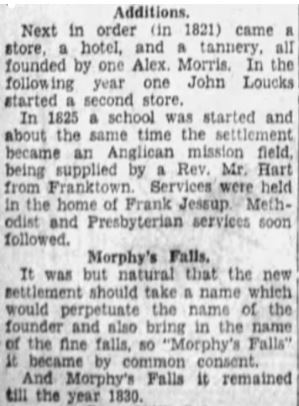
Methodist Church
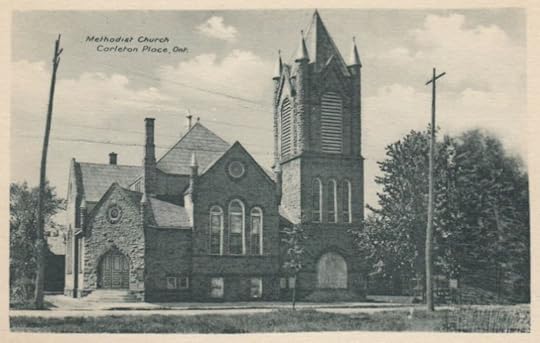
Carleton Place Methodist Church
“In 1830 a post office was first established and Caleb Bellows was the first Postmaster.”
Re-Named
“Nobody in Carleton Place at the present time (1928) can tell who gave the name Carleton Place…”
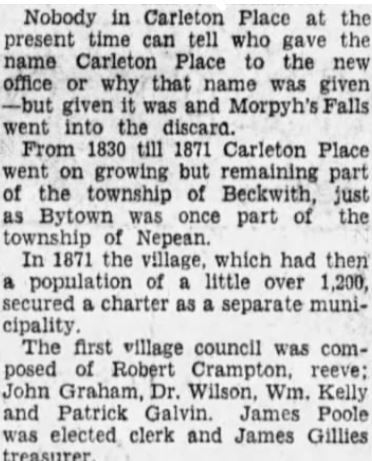
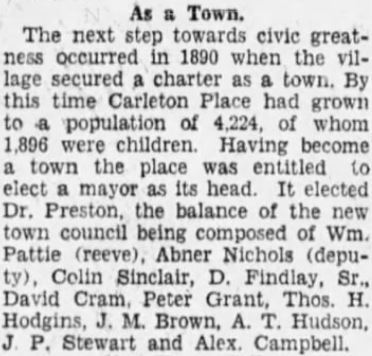
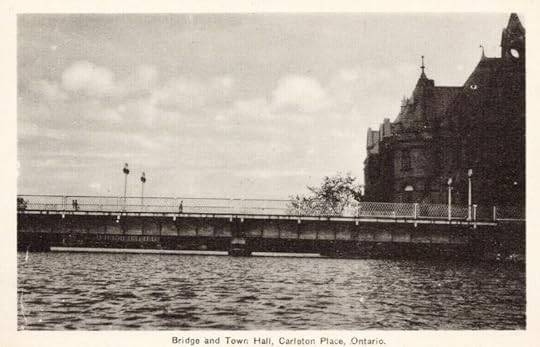
William Pattee
Opened New Bridge
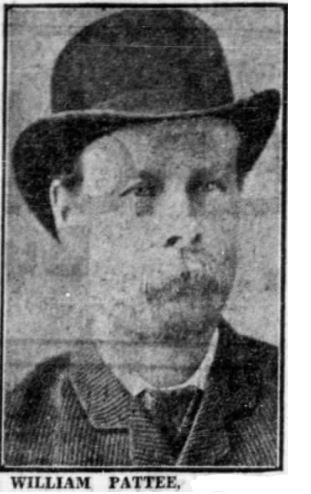
When the new ‘Central’ bridge opened in Carleton Place, in 1928, the honour of the official ‘opening of the bridge’ went to Carleton Place’s oldest citizen, 86 year old William Pattee.
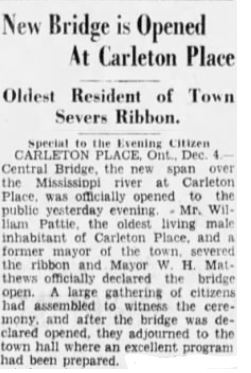
Dec. 5, 1928, p. 3, “The Ottawa Citizen”
Central Bridge
Under Construction
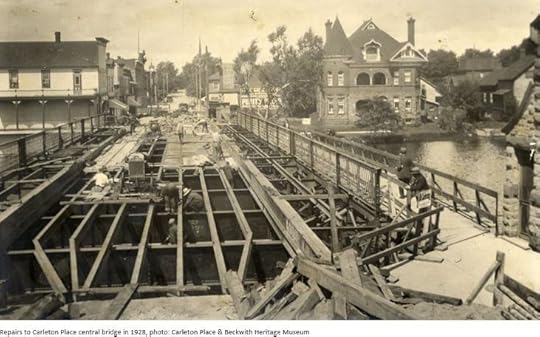
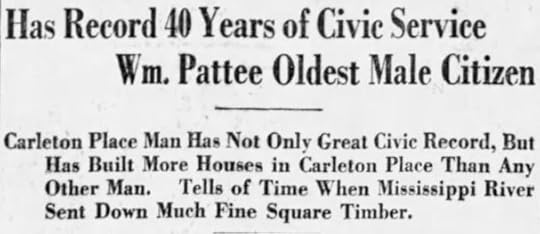

Carleton Place Orange Lodge – established in 1830, closed in 2015, after 185 years.
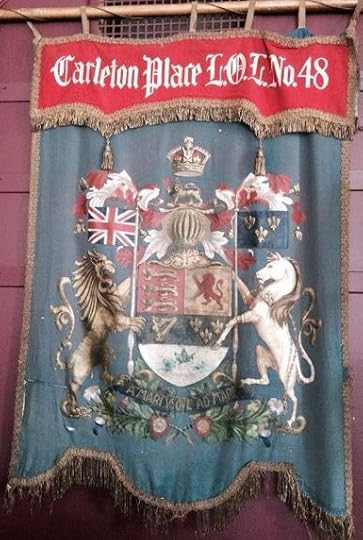
High School

Carleton Place High School – original building

Home of R. C. Patterson
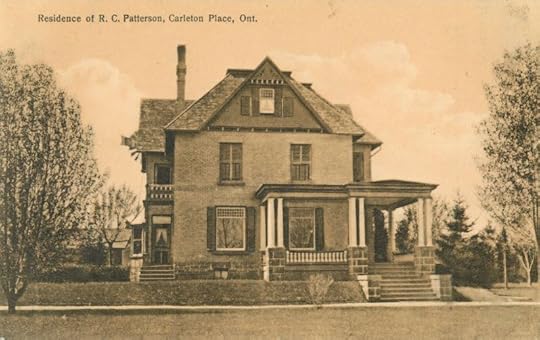
The Dam
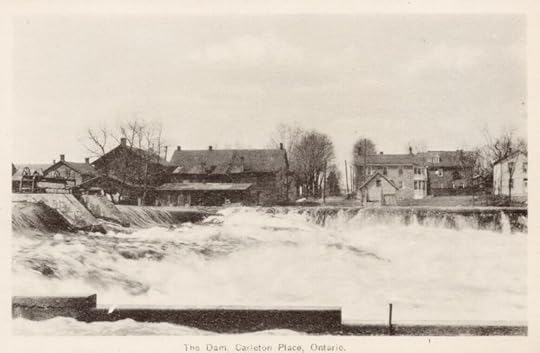
Morphy Cairn
In 1982, a cairn was erected on the site of the original Morphy home on Allan Street (a property owned by Bell Canada at that time) in memory of the first recorded settlers to Carleton Place.
An acre of land was reserved for the Morphy family’s burying ground at this site. Edmond, his wife and several family members rested here until the 1960’s, when their remains were re-interred at the united cemeteries – Pine Grove, Maple Wood, St. Fillan’s.

May they rest in peace.
I hope you enjoyed our trip down memory lane,
in our visit to Carleton Place in the good old days!

Arlene Stafford-Wilson
Member, Association of Professional Genealogists
Honorary Life Member, Lanark County Genealogical Society
Author of : “Lanark County Christmas”, “Lanark County Comfort”, “Lanark County Collection”, “Lanark County Calling”, “Lanark County Classics”, “Lanark County Connections”, “Lanark County Calendar”, “Lanark County Chronicle”, “Lanark County Kid”, & “Recipes & Recollections”
available at local stores or email: lanarkcountybooks@gmail.com
August 1, 2023
Mother’s Farmhouse Salad Dressing
“I’m making a salad!”, Mother would call from the kitchen.
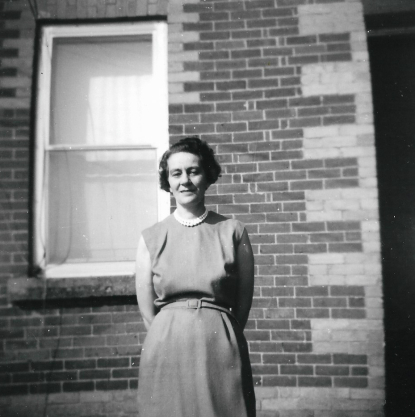 Audry Stafford at the Stafford house, 1963
Audry Stafford at the Stafford house, 1963Mother’s request for vegetables was my cue to go to the big wooden sideboard in the kitchen, grab one of the deep plastic mixing bowls and head outside to the garden.
 Stafford house, 3rd Line, Tay Valley Township
Stafford house, 3rd Line, Tay Valley TownshipThe old rope swing beckoned me as I passed by, but I was on a mission, so the swing would have to wait.

The vegetable garden was at the front of the old house, on the other side of the driveway, and so offered a splendid view of the Third Line, while I also glanced around at the long rows of flourishing plants, and decided where to begin my harvest.
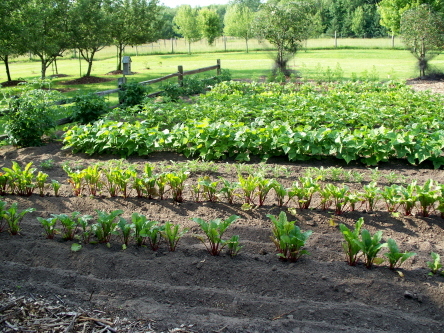
I always began with the carrots first; something to snack on while I chose the rest of the vegetables.
I’d find the biggest one, grab it firmly, close to the ground, give it a good yank and wipe it off on the grass. I’d break off the spindly end, and bite down, and give some thought to the next carrot that I would pull for our salad. I’d pull about three large ones, and then move onto the lettuce. Sometimes the lettuce was chewed a bit at the edges, so I’d try to find some perfect leaves that were all intact and pick a bunch of those.

Tomatoes were next, and I’d look for the reddest, ripest and largest to add to my plastic bowl. We usually grew ‘Beefsteak’ tomatoes, and they were juicy, flavourful and delicious on thick, toasted slices of Mother’s homemade bread.
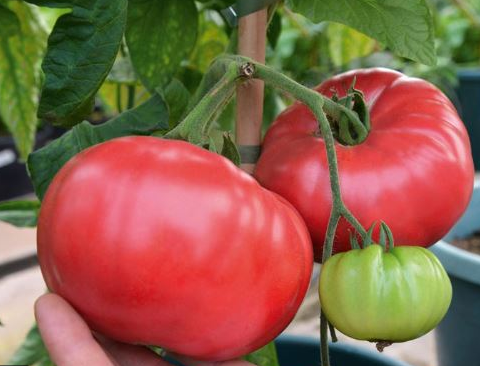
I would continue down the rows, breaking off one green pepper, and one ripe cucumber, then pull about four bunches of green onions from the ground. Sometimes Mother sliced the cucumbers and onions and soaked them in a glass of vinegar and water for a treat for us to have with supper.
The Dressing!Our food wasn’t fancy at home, but it was always fresh and Mother’s crowning glory for the salad was of course, her homemade dressing.
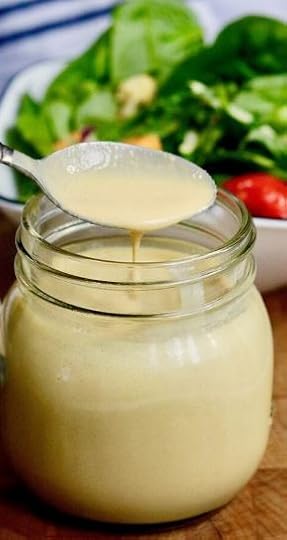
It was always a pleasure on those hot summer afternoons to go to our country garden, and marvel at the results of all of our hard work. The tiny seeds planted in the spring, along with the watering, weeding, and hoeing, had yielded these ripe and tasty vegetables for our table.
Though I’ve tasted many salads since those days so long ago, none could ever compare to the warm, ripe summer vegetables from our own country garden.
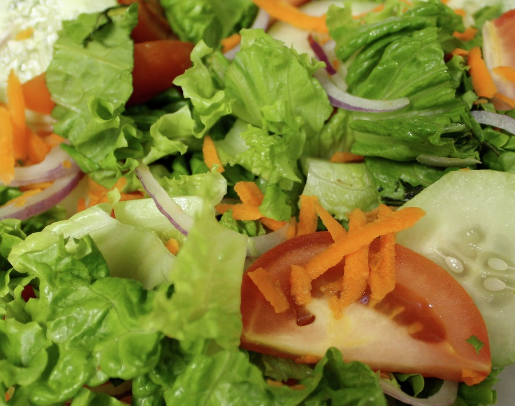 Mother’s Homemade Salad Dressing
Mother’s Homemade Salad Dressing1 c white sugar
2 Tbsp. flour
1/4 tsp salt
1 c vinegar
1 egg
1 heaping tsp dry mustard
1 cup milk
Measure dry ingredients into a saucepan
Mix well
Add egg and mix into a paste
Add milk, and stir
Add vinegar and cook, stirring occasionally until it boils.
Cool, and serve
Use on garden salads, raw veggies as a dip, on toasted tomato sandwiches, and the Stafford family’s favourite – in potato salad!(Salad Dressing – from Recipes & Recollections: Treats and Tales from Our Mother’s Kitchen, ISBN 9780987702609, p. 132)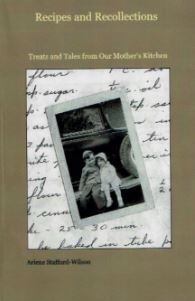
“Recipes and Recollections: Treats and Tales From Our Mother’s Kitchen”

Arlene Stafford-Wilson
Honorary Life Member, Lanark County Genealogical Society
Member, Association of Professional Genealogists
Author of : “Lanark County Christmas”, “Lanark County Comfort”, “Lanark County Collection”, “Lanark County Calling”, “Lanark County Classics”, “Lanark County Connections”, “Lanark County Calendar”, “Lanark County Chronicle”, “Lanark County Kid”, & “Recipes & Recollections”
July 28, 2023
Lake Life – A Rideau Ferry Love Story
They were a couple of crazy kids from Kirkland Lake – outdoorsy-types, loved to ski and ride ski-doos, and most of all, they loved each other. After high school, they enrolled at Carleton U. , married in 1982, settled down in Orleans, and raised a couple of kids.
Twenty years ago they went for a drive, and that was the first time they laid eyes on the Rideau Lakes. They’d never seen anything so blue, so peaceful, and so perfect. He looked at her and said, “This place feels like home.” And at that precise moment, they decided that someday they would build a house on that very spot.
At first, they bought a trailer, and a plot of land near the shoreline, and every season, without fail, they returned to the Big Rideau.
Their kids grew up, and they knew that it was time – time to sell the house in the suburbs and build their dream along the water’s edge. The Big Rideau had been calling their names for years, and they were finally able to answer.
Mornings begin now with pink skies at sunrise, and waves gently lapping the shores. Evenings wind down to the sound of the loons as the sun dips low along the horizon and eventually disappears into the lake.

A bumper crop of apples, along with a perennial Perth Fair prize-winning recipe for Applesauce Loaf from “Recipes & Recollections”, filled their lake house with the warm scents of home baking.
Time is spent lovingly restoring a 1961 classic boat to her former glory, and day-trips to Perth or Brockville, along the scenic Rideau waterway.

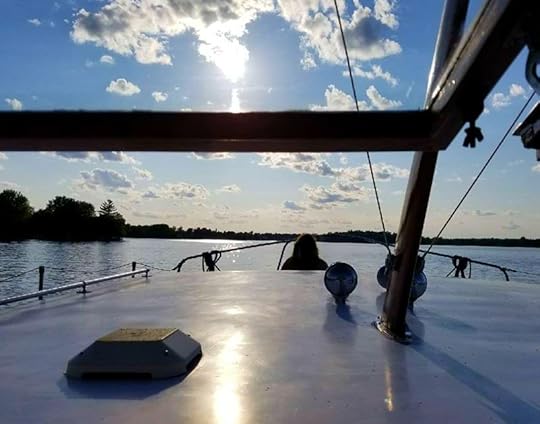
You never know who might stop by for a visit in Rideau Ferry!

Pull up a chair on the deck, and soak up the warm summer sun…
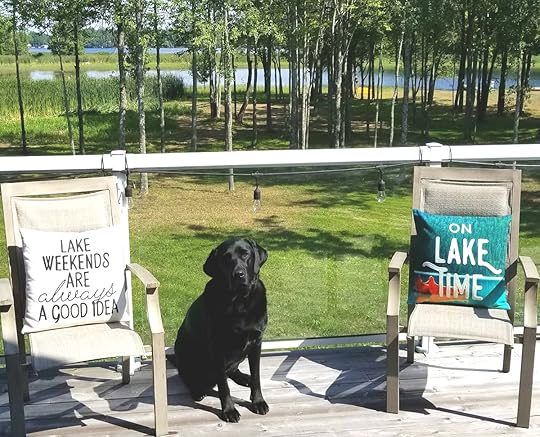
Make some new friends at the annual Rock the Dock…
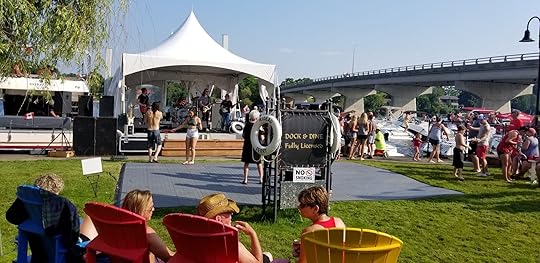
or dance the night away at the yearly corn roast, along the shores of the Big Rideau

Grab a cold drink, and sit outside at the fire pit.

Whether you feel like socializing, or would prefer a quiet evening listening to the sounds of the loons, there’s always something to do at the lake!

The beguiling charm of Rideau Ferry has been capturing the hearts of visitors and residents alike going back as far as the days of the pioneer settlers.
“One of the most notorious characters that passed his leisure time along the Rideau waterways was none other than Alphonse Gabriel “Al” Capone. Al Capone was a mobster based out of Chicago, and he made his fortune as a bootlegger, during prohibition.
He is said to have been a frequent visitor to a grand home in Kemptville, that was once owned by John Harris. Harris was a local who became a pharmacist, and worked in Chicago.
It has been suggested, that because of his background in chemistry and science, he was possibly cooking up quantities of moonshine in his home, and as you can imagine, this was of great interest to Capone.
In 1927 Harris built the beautiful, stone mansion that still stands today on Oxford Street in Kemptville. Locals say that the house was built with a state of the art security system, and series of underground passages. The grand home features leaded glass, a main switch to control all of the lights in the house, and a panic button wired directly to the local police station. It has yet to be confirmed that there are two tunnels leading from the house; one that links the home to the Kemptville Hotel, and the other which connects the house to the river.
Some of the stories have suggested that Capone himself hid a quarter of a million dollars, between the walls. Whether fact or fiction, witnesses, some of them lifelong residents of Kemptville, who were around in the 1930s and 40s, claim they saw many long, black limousines and the infamous black Cadillac parked at the home. Coincidentally or not, Harris sold the house, and moved away within a few weeks after Capone’s death.”
On a lighter note, one of the popular dance halls of the 1950s – 70s was known as the Rideau Ferry Inn. It was built on the site of what was originally a family home known as ‘Coutts House’.
After 1905, the building was rented to a series of business men. During the 1920s and 30s regattas became popular and Coutts House held canoe races and rowboats races. They also sponsored events for sailboats and it was the site of many grand daytime celebrations and intimate evening affairs for the wealthy travelers visiting in the summer.
In 1947 Doug Wallace, native of Osgoode, bought Coutts House, tore it down, and built a new structure, with wood framing and grey granite blocks. It was a two storey building and the second floor featured a large dance area with seating on three sides.
By the 1960s the building had become known as the Rideau Ferry Inn, and during this time became licensed for liquor sales. Up until that time people smuggled in their own booze, particularly in the roaring twenties when rum-running along the Rideau had its hey-day.”
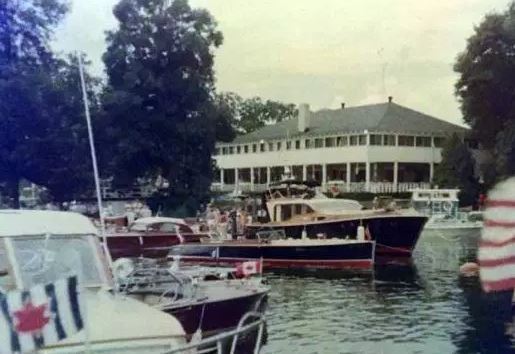
Whether you’re a visitor to the Rideau Lakes region, or living the ‘Lake Life’ like residents Ken and Carol-Ann McDougall, Rideau Ferry and its majestic, pristine waterways offers something for everyone.
With a rich history, and its striking beauty, the lakes are a wonderful place to pull up a chair and enjoy the view.
……………………………………………………………………………………………………………………………………………..
If you spend time around Rideau Ferry, you may hear these surnames that go back in the history of the area since the early days of the settlement:
Best
Bethune
Beveridge
Buchanan
Campbell
Cornell
Coutts
Covell
Crombie
Dettrick
Donaldson
Fitzgerald
Frost
Gallagher
Gemmill
Gould
Grierson
Hall
Hitchcock
Houze
Irving
Jackson
Johnson
Joynt
King
Mathews
McCue
McKay
McLean
McVeety
Millar
Miller
Moore
Oliver
Poole
Purdon
Reid
Richards
Rintoul
Runge
Sewell
Shaw
Smith
Stewart
Taylor
Thomlinson
Tully
Vandusen
Wallace
Wills
Wilson
Wood
——-
Excerpts on Coutts House, Rideau Ferry, and Al Capone’s heyday, taken from:“Lanark County Chronicle – Double Back to the Third Line” ISBN 978-0-9877026-26
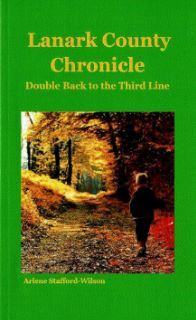
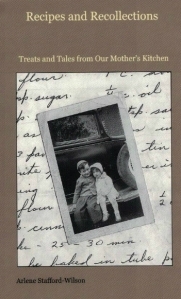
Arlene Stafford-Wilson
Honorary Life Member, Lanark County Genealogical Society
Member, Association of Professional Genealogists
Author of : “Lanark County Christmas”, “Lanark County Comfort”, “Lanark County Collection”, “Lanark County Calling”, “Lanark County Classics”, “Lanark County Connections”, “Lanark County Calendar”, “Lanark County Chronicle”, “Lanark County Kid”, & “Recipes & Recollections”
Stories set in Lanark County:
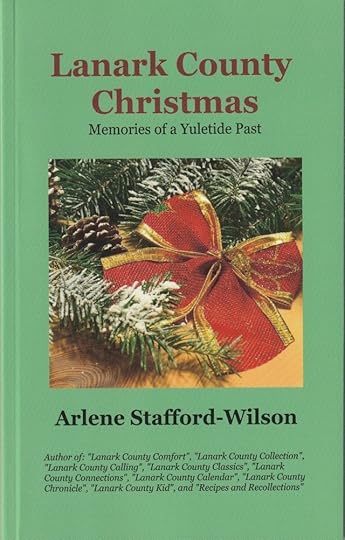
July 26, 2023
Norvic Lodge, Christie Lake

Norvic Lodge
Victor Lemieux and his wife Noreen (McGlade) Lemieux were owners and operators of Norivc Lodge. Like the other properties set along the shores of Christie Lake, they had a beautiful shoreline, framing their homey, rustic lodge.
Victor, son of Jeremie Lemieux, and Margaret Hannah James, was born and raised in the tiny village of Fournier, in the township of Prescott-Russell. The village is situated near the communities of Vankleek Hill, St. Isidore, and Plantagenet, a largely French-Canadian settlement. Victor’s father was a Lumberman, and his mother cared for the large family.
Victor’s wife, Noreen, grew up in the town of Perth, Ontario, the daughter of Arthur McGlade. The McGlade family were early settlers from Perth, originally from County Armagh, Ireland. Catherine McCarthy McGlade, Noreen’s mother, was also from an Irish pioneer family, from County Cork. Noreen’s parents were married in Toledo, Ontario, October 16, 1899.
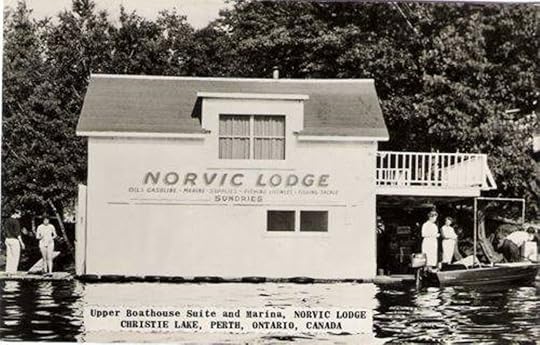
Norvic Lodge Boathouse, 1956
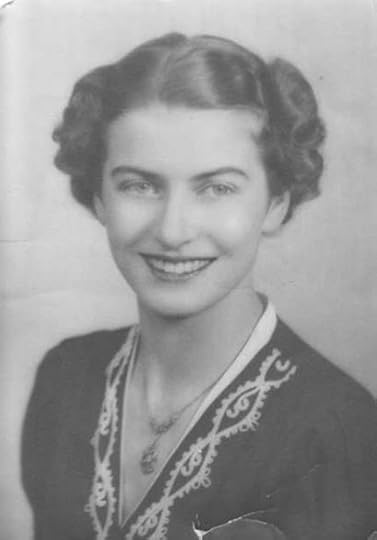
Noreen ‘Neen’ ‘Neena’ McGlade Lemiuex, Co-Owner, Norvic Lodge
Dining Room
at Norvic Lodge

Dining Room, Norvic Lodge, overlooking Christie Lake – c 1960
Working at
Norvic Lodge
Memories of working at Norvic Lodge in 1960, as told by Judy (Stafford) Ryan:
“The Lodge was ‘Norvic” named after the owners – Noreen and Vic. She was called Neena, ‘Neen’, and they had a daughter Judy, – about my age at the time. The Lodge was on Christie Lake.
I was the only one in our family who had the job there, but because I also had a two week job at the Optometrist in Perth, while his secretary was on vacation, at the beginning of the Summer (Dad got it for me), my sister Jackie (Stafford) Wharton, went up to the Lodge, and held my job for me for that two week period. I think Dad was also the one who got me the job at the Lodge. Mother did not want me to go as she figured I would get into trouble.
We were paid $10.00 a week which was given to us at the end of the Summer. We made great tips from the Americans, who stayed in the cabins – I could make up to $100.00 a week, depending on whether or not the cabins were full that week.
Our cabin was at the top of a hill away from the vacationers. Our day started at 7:00 a.m. We had to be down the hill to the Lodge in uniform, to set up the dining room for breakfast, take breakfast orders, serve it, clear tables and help wash dishes, etc. We then went back up the hill, changed into shorts and t-shirts and cleaned all the cabins – made beds, dusted, vacuumed, cleaned bathrooms, changed towels, etc. Then, back up the hill, back into uniform, to do the lunch thing.
We were supposed to have a couple of hours off each afternoon, to do what we wanted. However, part way through the summer, the lady who did the laundry left, and that was added to our jobs, without extra pay. So after lunch, we would have to do the laundry – sheets, towels, etc. and hang them out on a line to dry. Once a week, we would have to strip the beds, but changed the towels often.
On days when we didn’t have to do the laundry, I would take the canoe, and a good book, and head for a small uninhabited island, and read for a couple of hours. I knew that no-one could get to me there.
Between 4:00 and 5:00 p.m. we were back down the hill, in our uniforms, to set up for dinner, etc., etc.
After everything was done, and cleaned up for the evening, we had time to ourselves, if we had any energy left. I worked with a girl by the name of Claudette, and she was a real party girl, and as there was a party at some cottage every night, we went out most nights, along with the guy who worked at the Lodge store and gas bar, and he was allowed to use one of the motor boats, and that is how we got to the other cottages.
Just before I arrived to work at the Lodge that Summer there had been a bad boating accident, and I think one or two people had died. The only way I found out about it was I saw a mangled boat with blood on it, stored in behind the lodge, when I was out walking one day, and asked the guy at the gas bar what happened.
That Summer was the first time I saw death! There was a delightful family from Pennsylvania. there – three generations – Grandfather, parents, and two younger children. I was serving breakfast this one morning, and the Grandfather, who was always so friendly and animated, told me about the different birds he had heard singing that morning, and during the conversation, he keeled over at the table. I ran into the kitchen and got Vic (Lemieux) – told him the old man ‘fainted’. Vic got the son to help him carry the Grandfather into the Lounge, behind the dining room, and they put him on the couch. I remember going ahead and serving the other guests, and noticed people coming and going to the Lounge. Nina told me later that the old guy had died, probably instantly, and I was really shocked and upset. That is one of those memories that is permanently etched in your memory, especially when you are only 15.”

Norvic Lodge ad – 1971

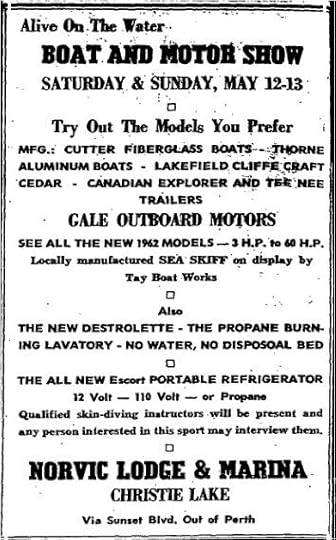
Ad – 1962
Waterskiing
at Norvic Lodge
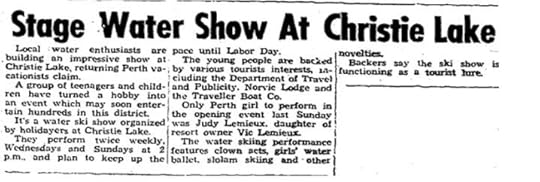
Waterskiing Show 1963
Christie Lake Surfers
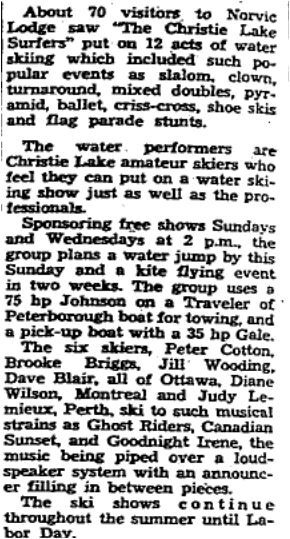

What became of Norvic Lodge?
Norvic Lodge closed many years ago, and so we are left with our memories of this special place – the home-cooked meals, Vic, Neena, the peaceful lake, the great fishing, and the excitement of the water-skiing shows will stay with us always.


Arlene Stafford-Wilson
Honorary Life Member, Lanark County Genealogical Society
Member, Association of Professional Genealogists
Author of : “Lanark County Christmas”, “Lanark County Comfort”, “Lanark County Collection”, “Lanark County Calling”, “Lanark County Classics”, “Lanark County Connections”, “Lanark County Calendar”, “Lanark County Chronicle”, “Lanark County Kid”, & “Recipes & Recollections”
July 20, 2023
Roclyn Mansion, Smiths Falls
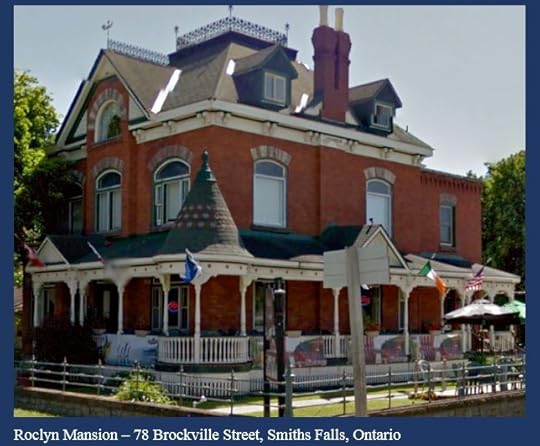
Roclyn Mansion
On a Sunday drive through the town of Smiths Falls, this elegant mansion is difficult to miss. Situated at the intersection of Brockville Street and Lombard Street, we might guess that the original owners, Ogle and Isabella Carss, intentionally built their lavish home in this location for maximum visibility. It appears like a grand and glorious castle, a stately haven of tranquility rising tall and proud amidst the hustle and bustle of passing traffic, honking horns, and the curious stares of passerbys.
Roclyn Mansion is an example of the Queen Anne Revival architectural style, as seen in the multiple sloped roofs, the cast-iron railings, the tower, and the long elegant verandah. Today, we can only wonder what went on behind those tall red brick walls in the early days? Who sat on that spacious sweeping verandah, sipping cool drinks, sheltered from the hot sun, living a life that few could only dream of?
It’s been said that the lady of the house, Isabella, designed the home, working alongside the architects, overseeing many of the particulars of the room dimensions, function of the living spaces, and directing the interior design and decoration. The end result was spacious, elegant, and fit for a prominent wealthy family like theirs. Isabella’s husband, Ogle, was a captain of industry in the town, owner of the Canada Clothing Company, he also operated the steamship, “Olive”, that sailed up and down the Rideau River. He was a respected member of the Smiths Falls Board of Trade, served as Mayor in 1890-91, held the rank of Grand Registrar with the Masonic Order, Town Councillor, local land developer, and was a generous contributer to the funds raised to build the Smiths Falls Hospital.
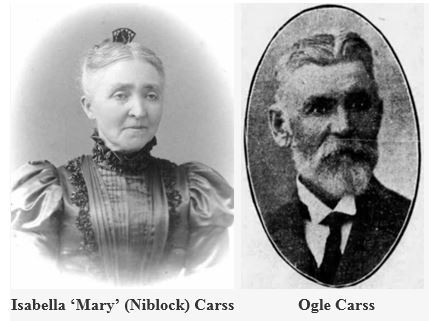
Ogle Carss
Ogle (1846-1925) was born in Phillipsville, a small hamlet south east of Smiths Falls, the son of James Carss, who came from County Wexford, Ireland, and his wife, Alice Wilson, also from Ireland. At the age of 26, Ogle married Isabella Niblock, age 25, (1847-1937), daughter of James Niblock of Belfast, Ireland, and Sarah Ann Foster, of Rosscommon, Ireland. They had four children: Lila, (1873-1968), James, (1875-1934), Ethel (1877-1881), and Henry (1879-1882). Of the four children only Lila and James survived to adulthood. In a diptheria outbreak the two youngest children, Ethel, age 4, passed away two days before Christmas, December 23, 1881, and their youngest, Henry, died three weeks later, on January 13, 1882. At that time there was no treatment nor cure for diptheria.
Lila and George Carss
Lila, like her mother, was gifted musically, and, following in her mother’s footsteps, she became a music teacher.
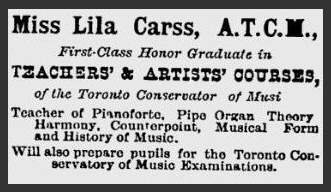
Lila, age 47, moved to Toronto in 1920 with her parents, when Ogle retired from public life at age 74. James, age 45, was already established in a law practice there. Both children remained in Toronto and chose to live out their years there.
“Mr. and Mrs. Ogle Carss and daughter, Miss Lila, left on Thursday for Toronto, where they will in future reside. Mr. and Mrs. Carss were among the oldest and best known residents of Smiths Falls and their removal from town will be regretted by a large circle of friends. They had lived here for more than 40 years, and in all those years Mr. Carss had taken a prominent part in the life of the town. He had served in the coucil, and had been Mayor, and during his residence of two score years was actively interested in many enterprises.”
July 17, 1920, “Ottawa Journal”

Lila and James, 1882

Lila Carss, during her days as a music teacher
Lila continued her career as a music teacher, and after her father’s death, she and her mother, Isabella, lived in a lovely home in the Forest Hill community. On Sunday, November 28, 1937, at her home, 393 Tweedsmuir Avenue, Toronto, Isabella Carss, died in her 91st year. Lila passed away in 1968, at the age of 94.
“Ogle Carss is head of the Canada Clothing Company, one of the long established mercantile concerns of the town. He is one of the town’s substantial citizens, and has been a resident for many years. He has served as Councillor and Mayor, and has been long connected with the Board of Trade.”
Feb. 8, 1913, p. 26, “The Ottawa Citizen”
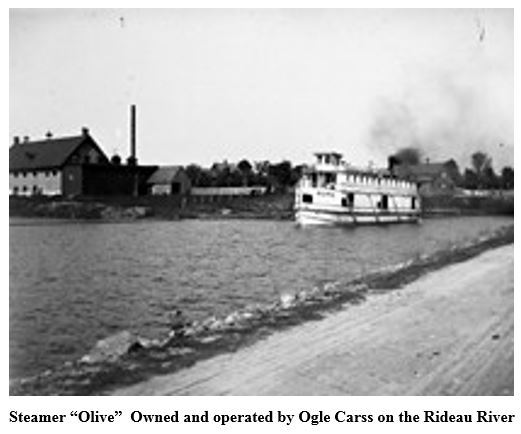
Their son, James Carss
James studied law and became well known in the Toronto legal circles of his time. In 1921, at age 46, one year after his parents and Lila moved to Toronto, he married Mabel Kilner, age 25, daughter of William Kilner and Jemima Carroll.
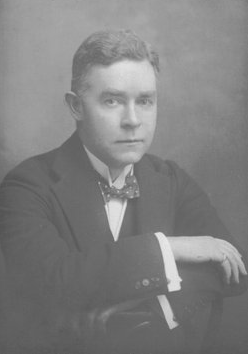
James Ogle Carss
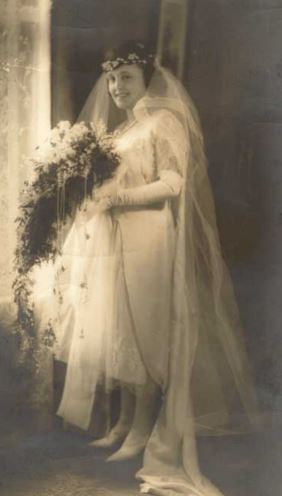
Mabel (Kilner) Carss, on her wedding day, June 1921
James and Mable had three children: Thomas Ogle Carss (1922-2015), Marjorie Kilner Carss (1924-2006), and Carol Isobel Carss (1929-2022)
Building the Mansion
Although some sources say that Ogle and Isabella Carss built their home in 1895, there is an article in the “Almonte Gazette” from August of 1878, which mentions a severe thunderstorm in Smiths Falls, which causes some damage to Ogle’s ‘new house’:
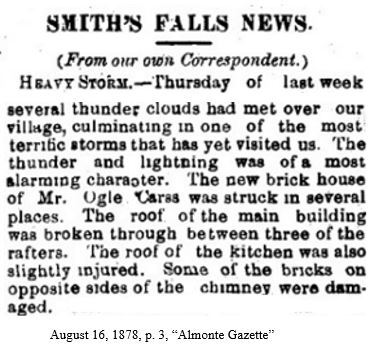
Roclyn Mansion
in the Old Days

Ogle and Isabella Carss’ mansion, Roclyn, in the early days
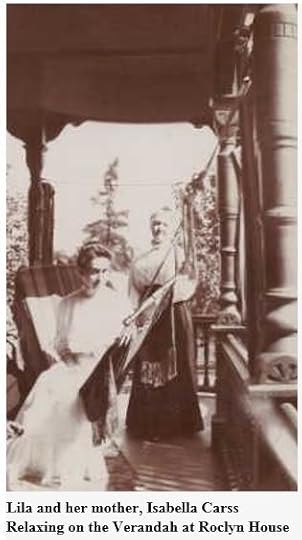
Roclyn Mansion
in Modern Times
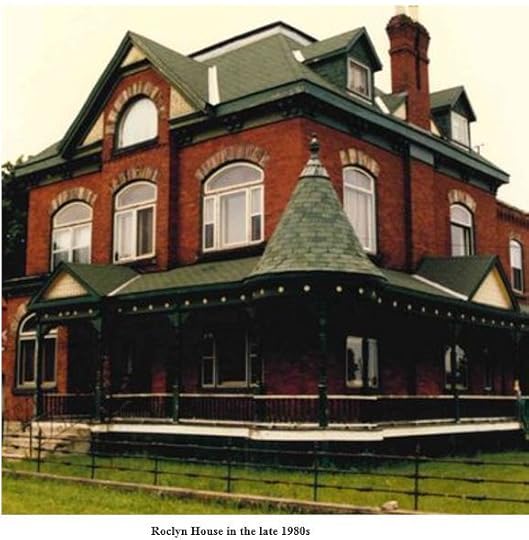
In the fall of 1992, well-known local artist, Ben Babelowsky, (1932-2019) captured the splendour of the grand old Roclyn House in Smiths Falls. At that time, it had been converted to a restaurant and was known as the ‘Roclyn Roast Beef House’.
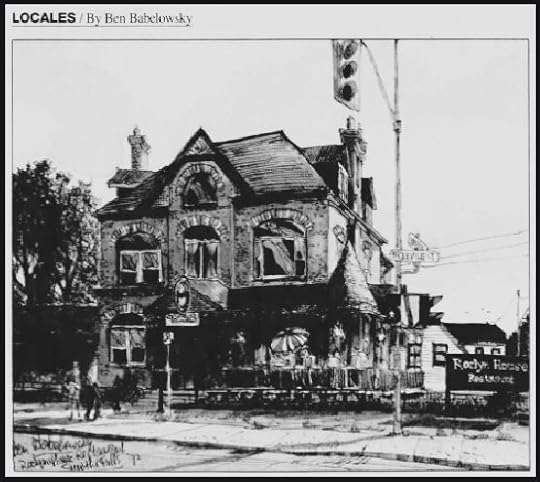

Oct. 18, 1992, p. 33, “The Ottawa Citizen”
Kilt and Castle
Another restaurant opened in Roclyn House, called the “Kilt and Castle”, and after it closed, the building was purchased in 2017 by Lisa McLean, with the intention of converting the property to a bed and breakfast.
In an article on Roclyn House, published in the Smiths Falls Record News, “Inside Ottawa Valley”, April 11, 2018:
“According to a town report presented to council’s committee April 9, 2018 the property is in a state of disrepair, and currently unusable.
The new owners are in the midst of repairs and renovations that they hope will be completed by August 2018.“
(The owners were applying to the town of Smiths Falls for a reduced tax rate while the building wasn’t fit for habitation, with the understanding that the property taxes would be reinstated after the house was deemed safe for occupancy.)
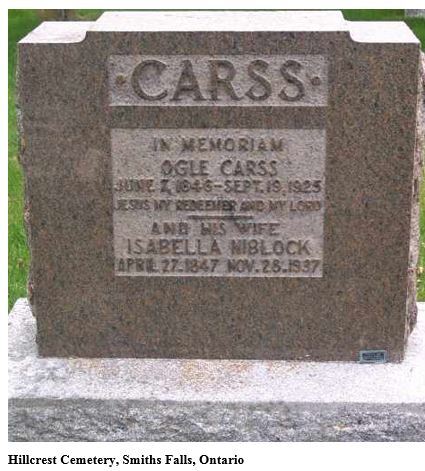
Restoration?
Will the Roclyn Mansion ever be restored to her former glory? Will another family enjoy cool drinks and a warm summer breeze on the verandah like socialite Isabella Carss and her lovely daughter, Lila? Will the house once again be filled with the sounds of music as it was in the early days when Lila taught music to her eager students, while Isabella looked on with pride?

We can only imagine the glory days of Roclyn House, when this prominent Smiths Falls family graced the rooms and hallways, entertained prominent members of the local political and social community, and gazed out from their lofty perch on the top floor, of this very special architectural gem.
*************************
sources: news clippings – various – “Almonte Gazette”, “Ottawa Journal”, Ottawa Citizen”, “Inside Ottawa Valley”, Carss family photos: Ancestry.com. Public Member Photos & Scanned Documents, other photos: Library & Archives Canada – public domain.
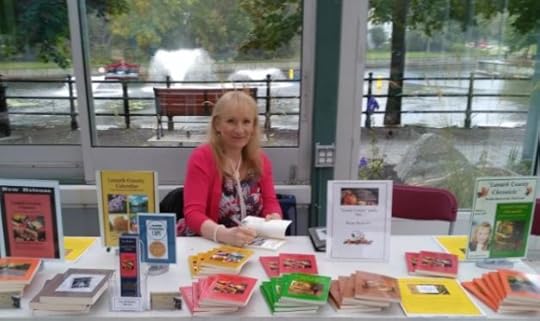
Arlene Stafford-Wilson
Member, Association of Professional Genealogists
Honorary Life Member, Lanark County Genealogical Society
Author of : “Lanark County Christmas”, “Lanark County Comfort”, “Lanark County Collection”, “Lanark County Calling”, “Lanark County Classics”, “Lanark County Connections”, “Lanark County Calendar”, “Lanark County Chronicle”, “Lanark County Kid”, & “Recipes & Recollections”
available at local stores or email: lanarkcountybooks@gmail.com
July 12, 2023
My Mother, she was Orange…..and my Father, he was Green
“You picked a hell of a day to get married!”
Those were the first words spoken to our mother, the day she met her new father-in-law, Vince Stafford. He was referring to the fact that they were married on the twelfth of July. He made it quite clear that he was not pleased that his son had chosen to welcome a Protestant into their Roman Catholic family, on July 12th of all days!
Some called it Orangeman’s Day, and some referred to it as the ‘Glorious Twelfth’. On July 12th each year, Protestant organizations celebrated the victory of Protestant King William of Orange, riding a white horse, who defeated Catholic King James, at the Battle of the Boyne in July 1690.
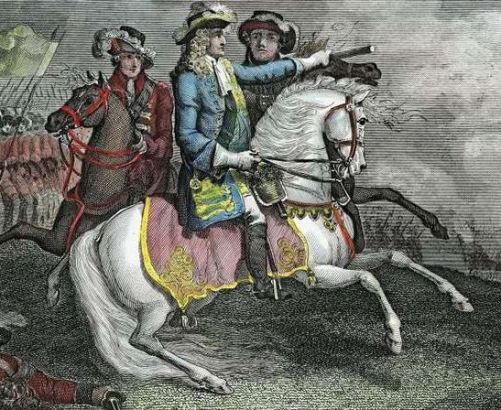
When I was a kid, the Irish Rovers recorded a song called “The Orange and the Green”, about a child growing up with one Roman Catholic parent, and one Protestant parent. We saw them perform the song many times over on a popular television show called ‘The Pig and Whistle’, and the irony of the song was not lost on us.
Irish Rovers “The Orange and Green”
Our father, a Roman Catholic, from Drummond Township, grew up attending St. Patrick’s church in Ferguson Falls, while our mother attended Calvin United in Bathurst (Tay Valley) Township.
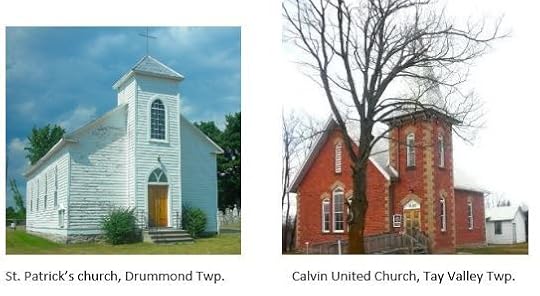
Although the feelings of bias and animosity between these two religions may seem foreign to us in these more inclusive times, they were still very much in the forefront, during the 1940s, when my parents married. Mother said she never felt accepted by Dad’s family, particularly his parents; and that never changed even up to the late 1950s and early 1960s when the in-laws passed away.
This religious prejudice ran on both sides of the fence. I recall our cousin, Ruth Rutherford, in Ogdensburg, New York, was forbidden to marry her sweetheart, a Catholic lad, and she never got over it. She remained single for the rest of her life, unable to marry her true love.
It may be difficult for us to imagine, but there were times in our early history in Canada where it was not uncommon for the July 12th celebrations to result in violence or even death.
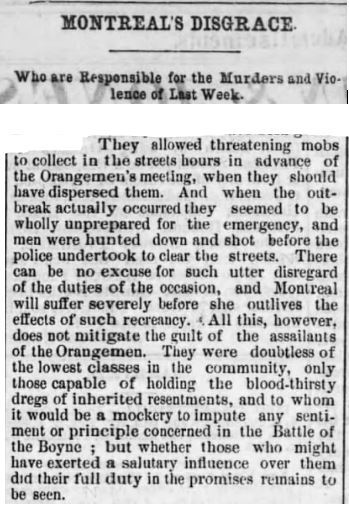
In the early years of the last century, the Orangemen’s Day parades in Canada drew crowds in the thousands, and it was not unusual for fights to break out, and insults along with injuries were to be expected.

Although Orangeism originated in Ireland and England, Ogle Robert Gowan, the Order’s first Canadian Grand Master is recognized as the founder of Canadian Orangeism. It is interesting that Gowan is known to have been a frequent visitor to a local fortune teller, Mother Barnes, the Witch of Plum Hollow. Not wishing to be seen consulting a sooth-sayer, he often sent his wife and their maid to ask questions about his politics and his career.
Orange Lodges, as the membership halls were called, sprang up all over Canada, and in Eastern Ontario, they were a common sight in almost every community. The closest Orange Hall to our house was at Wemyss, frequently used as a dance hall, and a place to play cards and socialize.

Carleton Place was one of the first communities to establish a Loyal Orange Lodge, along with Perth, Smiths Falls, and Montague Township.
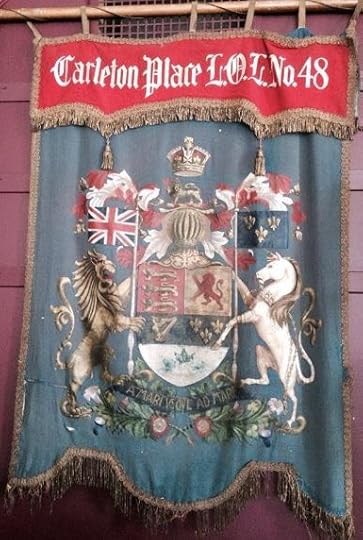
In the early days, thousands attended Orange events:
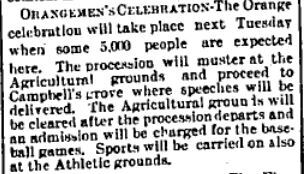
Through the decades, many community organizations also held their meetings and socials at the local Orange halls.
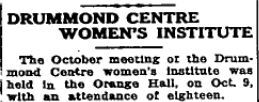
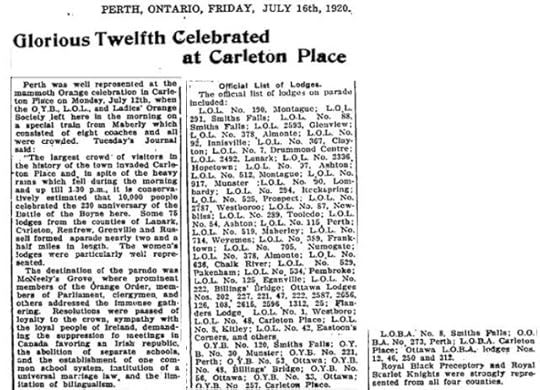
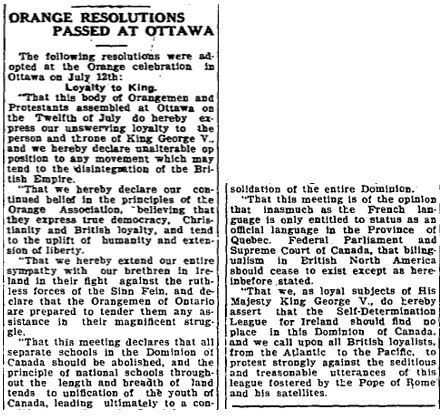
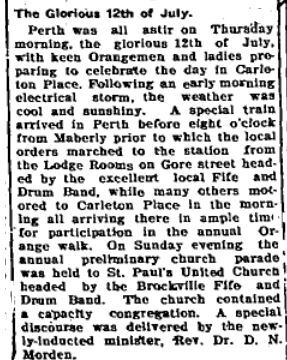

An Orange parade was often led by one of the members on a white horse, symbolizing the white horse ridden by King William of Orange, at the Battle of the Boyne.
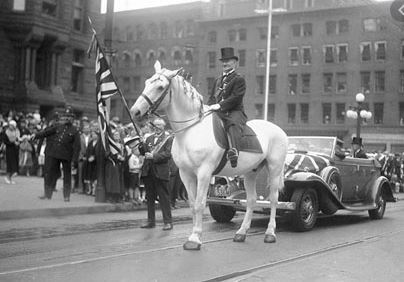
Some of the symbols worn by members of the Orange Order

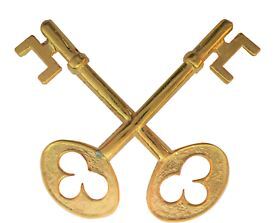
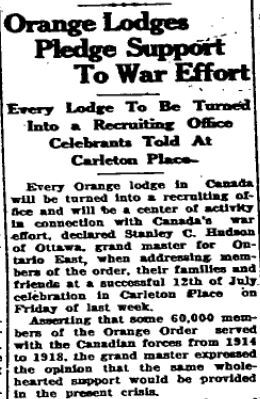
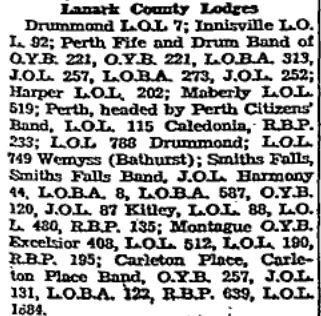
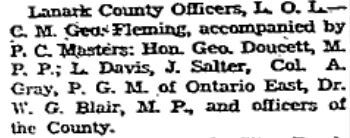
In 1957, the Orange Day celebrations were held in Almonte, and Rev. Canon J.W.R. Meaken, shared some comments as part of his address to begin the meeting:
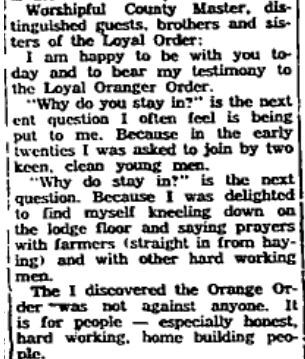
Interest in joining the Orange Order began to dwindle in the 1960s and 1970s, and instead of thousands attending the annual parade, it became ‘hundreds’.

Memberships grew smaller and smaller in many parts of the country, and in Lanark County, one of the oldest Orange Lodges, in Carleton Place, closed after 185 years, in January of 2015. The existing membership would merge with the Montague lodge # 512. (The Grand Lodge of Ireland issued the original warrant for the Carleton Place Lodge back in 1830.)

At one time, there were 30 Lodges throughout Lanark County. After the closing of the Carleton Place Lodge in 2015, only the Montague Lodge and the Smiths Falls Lodge (No. 88), remained. The Almonte Lodge (No. 378) amalgamated with Carleton Place in 1987, Franktown in Beckwith Township (No. 381) in 1992, and Drummond Centre in Drummond/North Elmsley Township (No. 7) in 2013.
…………
Throughout the many decades of the celebration of Orangemen, their sometimes vocal, and occasionally violent encounters with the Catholics, our family will continue to celebrate July 12th for a different reason. July 12th, for us, was the joining of the two religions, historically separated on this date, a young Protestant girl from the west, and a handsome Roman Catholic lad from Drummond Township.

Maybe they were ahead of their time. It was 1943 afterall, and marrying outside of one’s religion was often frowned upon. Luckily for us, the five children that followed in this unconventional marriage, would grow up in a home where we learned to respect different opinions, different points of view, and different religions.
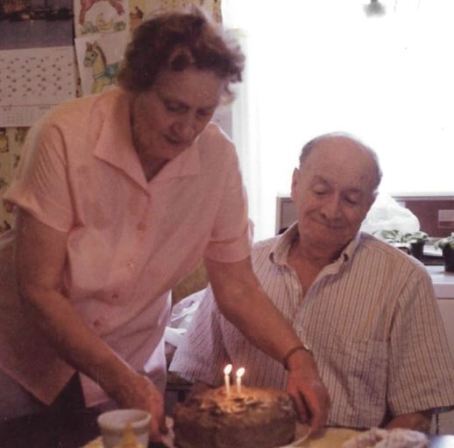
And so, the Protestant girl, and the Catholic boy were married for almost 50 years, until Dad passed away.
I still smile when I hear that Irish Rover’s tune, “The Orange and the Green”, and July 12th, for us, will always be a special day in our own family history.
………….
Arlene Stafford-Wilson
Honorary Life Member, Lanark County Genealogical Society
Member, Association of Professional Genealogists
Author of : “Lanark County Christmas”, “Lanark County Comfort”, “Lanark County Collection”, “Lanark County Calling”, “Lanark County Classics”, “Lanark County Connections”, “Lanark County Calendar”, “Lanark County Chronicle”, “Lanark County Kid”, & “Recipes & Recollections”
July 8, 2023
Silver Lake Sundays
It always seemed as though Highway 7 was busy, cars and trucks rushing along, especially on the weekends, and even more so during the summer months. According to Dad, it wasn’t just the local people travelling between Perth and Sharbot Lake, but all the tourists that rambled along the Trans-Canada Highway, doing a little sight-seeing, and exploring the countryside. Whatever the reason, Highway 7 was busy as usual that Sunday afternoon so long ago, as we made our way to Silver Lake.
Although it was just a twenty minute drive from the old house, the ride seemed to take forever, our legs sticking to the hot vinyl seats in the back of the Buick, long before the days of air conditioning. It wasn’t until I saw the signs for the village of Maberly that I breathed a sigh of relief, knowing we’d be there in just a few more minutes. Dad flicked on his signal, I felt the car slow down, and we turned, and drove up the hill to the entry booth at Silver Lake Provincial Park. The park worker came over to the window, Dad showed his seasons pass, and he waved us through.

Dad found a spot close to the picnic area, and we drove in and parked the car. That was the easy part. The tricky part was finding just the right picnic table. Dad liked a table to be in the shade. Mother preferred a place with a little sun. Dad said he needed to be out of the wind so he could light his little green Coleman stove. Mother liked a breeze to keep the bugs away. So the hunt for the best table usually took a little longer, sometimes a lot longer, than it should have. After all, we just wanted to cool off in the water, and that beautiful lake stretching out ahead of us, sparkling in the sun, was all we could think about. Who cared where we ate supper?
The hunt for the perfect table continued. Should we use one of the tables under the shelter in case it rained, or maybe one of the ones farther up the hill, off by itself? There was a good table close to the main beach, but there were a bunch of rowdy people sitting at the table right next to it, and Mother wondered aloud if that’s why no one else was using it.
They finally spotted a table halfway up the hill, toward the lower beach, and sent one of us up the ridge to ‘save’ it. Dad opened the trunk, and we each grabbed something, and made our way up to the table. The table cloth, Coleman stove, cooler, plastic cups and plates, paper napkins, transistor radio, saucepans, and cooking utensils, were all brought to the site. We hauled the picnic gear up the slope, and set it all down on the seats, while Mother spread out the red plastic table cloth. It wasn’t until we placed the big cooler on the table that we noticed that the table rocked back and forth. Good grief! I hoped to myself that we wouldn’t have to pick another table! Dad got the boys to lift one end, while he lifted the other, and re-positioned it until it was stable. What a relief!
While Mother took everything out of the cooler, Dad turned on his portable radio, extended the antenna, and went about setting up his little green metal stove.

I grabbed a towel from the top of the cooler, and headed down to the beach, finally free to jump in the lake and get cooled off. As I got closer to the beach, the noise and laughter from all of the kids grew louder, and I could see people jumping off of rubber rafts, and throwing beach balls around, and some little kids were filling up sand pails, and making sand castles along the shore.
I stepped cautiously into the shallow water along the sandy shore and it felt cool. Because I was right in the center of the main beach, I got splashed again and again by the other kids running in and out and jumping nearby. I walked out slowly, up to my knees, and then finally plunged in all the way, and the water didn’t seem cool anymore; it was just perfect. There was a kid close by with a diving mask on, and another kid with a fancy inflatable raft, and he was gliding along the surface using his hands to propel himself. I wondered what it would be like to have these expensive gadgets to play with in the water. We had an old beach ball that kept shrinking because it leaked air, and that was about it. Oh well, it was fun to splash around and cool off just the same.
I put my face in the water and opened my eyes. The bottom was sandy, with some smooth pebbles, and a couple of snail shells. There were some tiny minnows darting around, and lots of arms and legs of kids playing nearby. I pulled my face back out of the water, took a deep breath, and propelled myself down to the bottom, pushing the water back with my arms, moving farther from the beach. When I felt myself running out of air I resurfaced, rubbed my eyes, and looked back at the beach. There were lots of parents relaxing in lawn chairs, watching their kids swim. Little kids were playing close to the shore, and bigger kids were splashing around, squealing, laughing, and the bright July sun gleamed and glistened on the surface of the water.
I played in the water for hours, bobbing at the surface, swimming along the bottom, jumping into the gentle waves, and floating on my back and kicking my feet, then gliding backwards, staring up at the bright sun and the blue sky. I watched as new kids came into the water, and other kids left the beach, heading over to the playground, past the parking lot. By the time Mother came down to the beach to call me for supper I’d had plenty of time to swim, my fingertips were wrinkly, and I was ready to come out of the water.
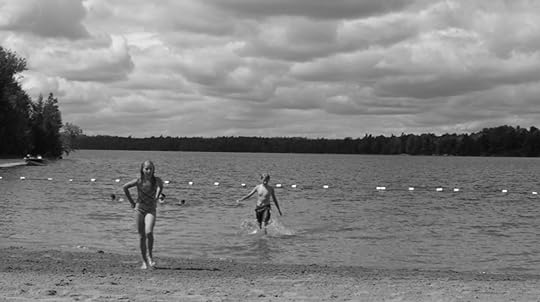
As we walked up the path to the picnic table I began to smell the gas from the Coleman stove, and the savoury scent of the hot dogs, and I began to realize how hungry I was. The fresh corn was already boiled and stacked on a tray. There was a bowl of baked beans, a homemade potato salad, some deviled eggs, homemade rolls, pickles, and a jellied salad. Everything tasted good, partly because I was hungry from swimming, but mostly because we were outside. Things always seemed to taste better outdoors in the fresh air for some reason. Dessert was Mother’s lemon squares. There was also a cookie tin of brownies, and some butter tarts. No one went hungry at our picnics; that was for sure.
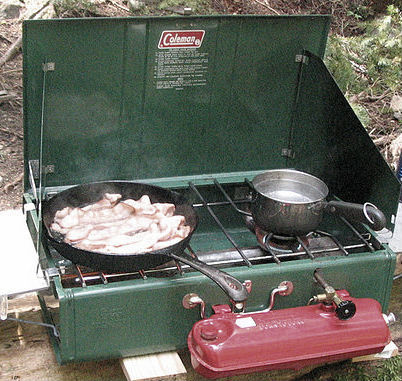
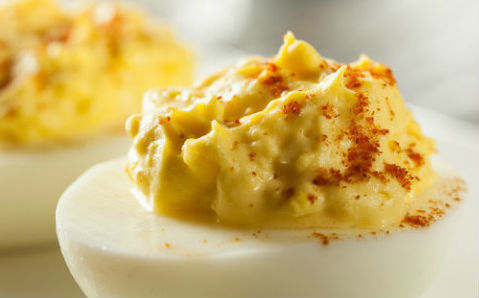

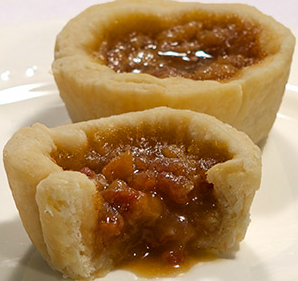
After we’d finished and cleaned up, we decided to walk across the road to Barbary’s store. The traffic was very busy on Highway 7, so we had to wait quite a while until both lanes were clear, and then walked quickly across. The store was huge, and they had everything – groceries, camping gear, water toys, even life jackets; anything that you might need if you were camping, or visiting the lake. They had lots of souvenirs, postcards, and knick-knacks for tourists. Dad asked me if I’d like a chocolate bar, but I’d spotted something even better. The store carried Partridge Family bubblegum cards, and I was collecting them, so I asked if I could have those instead. Dad agreed and bought me those, and bought chocolate bars for everyone else, and he also picked up a fly swatter that he’d spotted hanging up by the cash register.
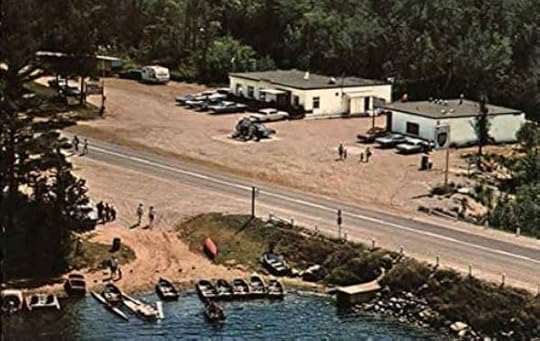
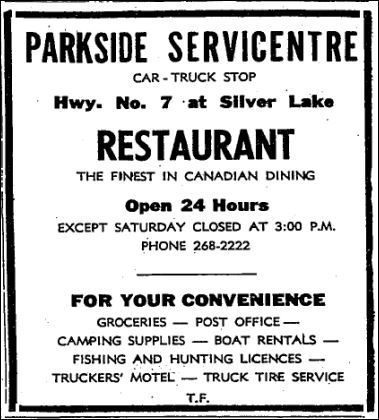

We left the store, and once again waited a while until the road was clear, and walked quickly across. We strolled up the hill to the park entrance, through the gates, past the washrooms and change rooms, down the hill through the parking lot, and back up to the picnic table. We each picked up something, and headed down the hill to the car, and packed everything back into the trunk.
Once the car was packed, we went for a walk along the smaller, quieter beach on the other side of the picnic area. It was more peaceful at that beach, and there were only one or two kids with their parents down near the water. As we walked along I picked up some smooth stones, and a couple of snail shells, to bring back home. The early evening sun was lower in the sky, but still bright, and it bounced and played off of the water, and shimmered through the trees along the shore. The air was fresh and clean, and carried with it the soft scents of the lake and the nearby trees.
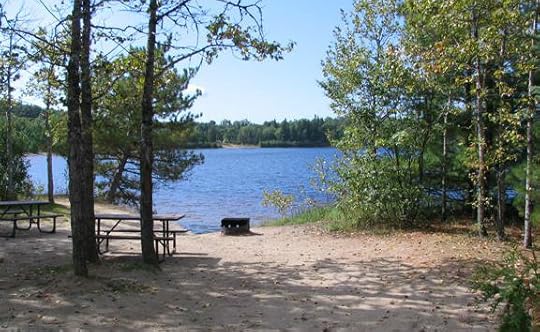
Many Sunday afternoons were spent at Silver Lake. There were no splash pads, or giant water slides. We swam without water wings. Our only concern was how fast we could get into the lake to swim, and not how we looked in our bathing suits. The old car had no air conditioning, and our entertainment at supper consisted of a small transistor radio. If we wanted to call a friend we had to wait ‘til we got home and hope that none of the neighbours was using the party line. We filled our dinner plates time and again, stuffed ourselves with desserts, and never counted a single calorie. We didn’t send text messages; instead we talked to each other, and shared a few laughs.
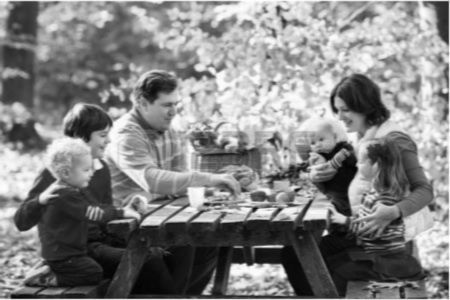
Although there have been many useful advances in technology since those days, I will always treasure our simple summer picnics. I yearn for the clear water, the beach-scented air, and quiet walks along the sandy shores. I miss the shrieks of genuine laughter, and carefree splashing in the warm waves. I dream of the distinctive smell of the Coleman stove, and the unmistakable flavours of the homemade comfort foods. Most of all, I long for the effortless, unguarded conversations that we shared between bites. Surely in today’s hectic, stressful world, constantly connected to the internet, we could all find some welcome relief in the peace, tranquility and simplicity of an old fashioned picnic at the lake.
Arlene Stafford-Wilson
Honorary Life Member, Lanark County Genealogical Society
Member, Association of Professional Genealogists
Author of : “Lanark County Christmas”, “Lanark County Comfort”, “Lanark County Collection”, “Lanark County Calling”, “Lanark County Classics”, “Lanark County Connections”, “Lanark County Calendar”, “Lanark County Chronicle”, “Lanark County Kid”, & “Recipes & Recollections”




